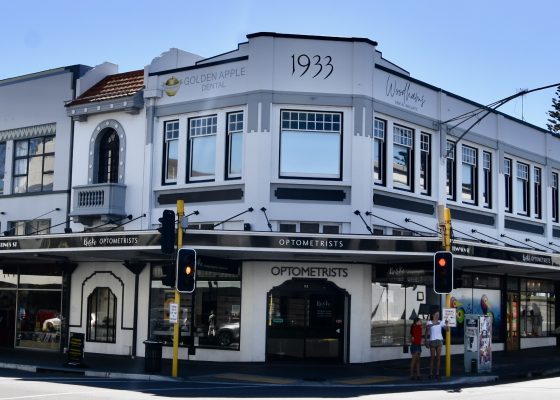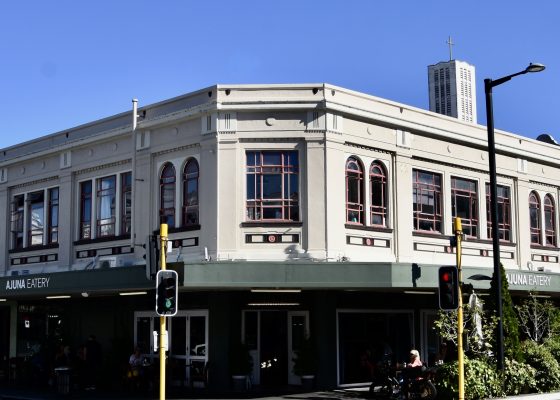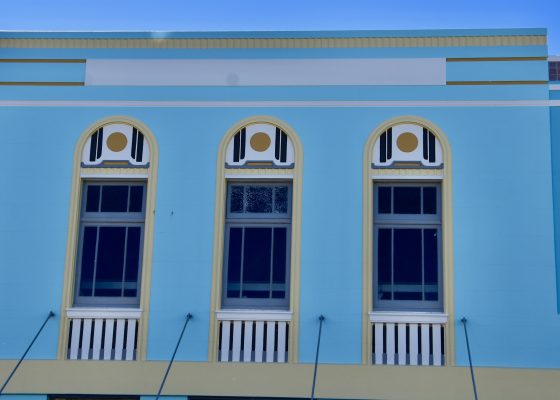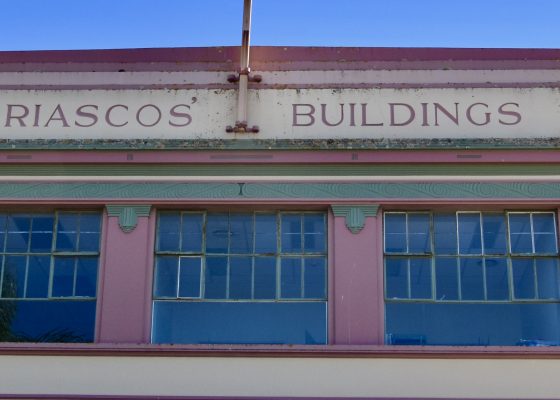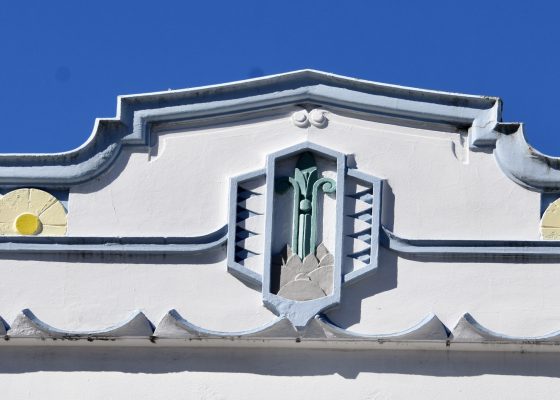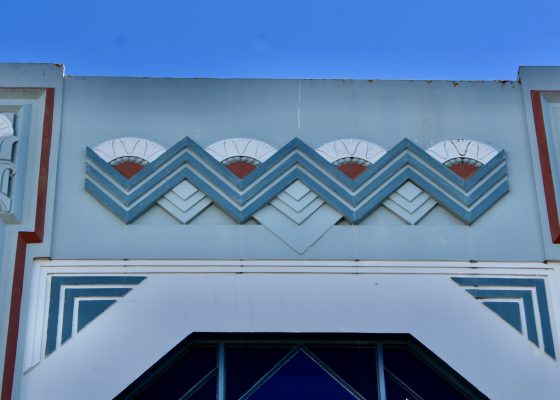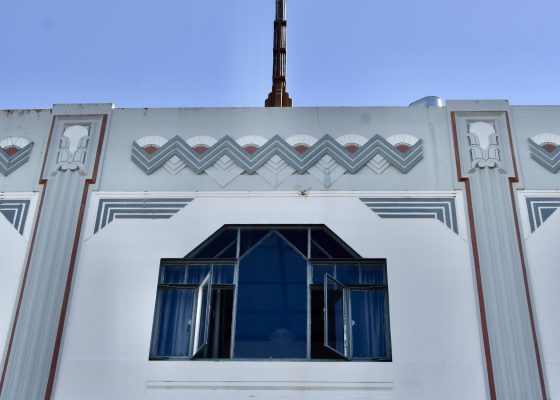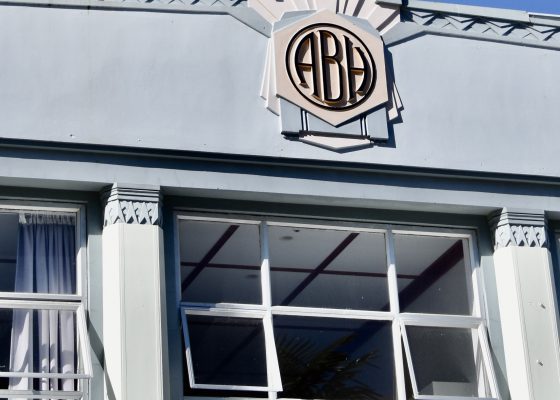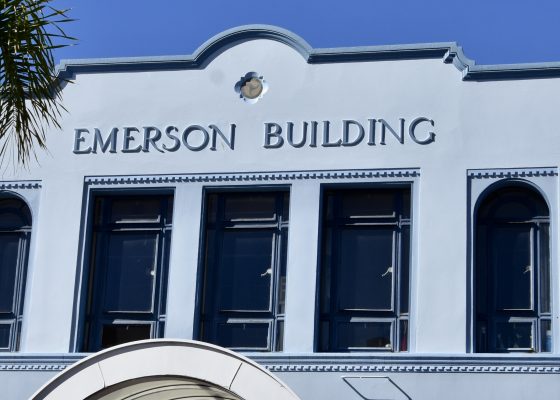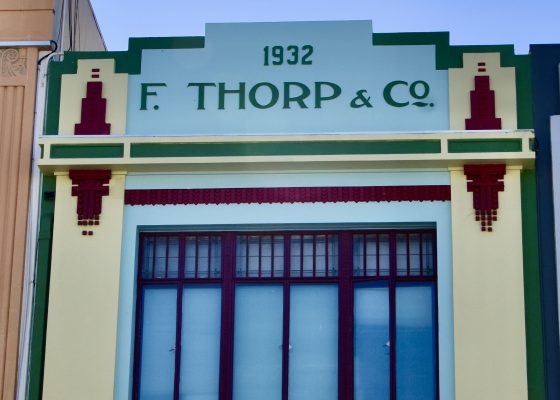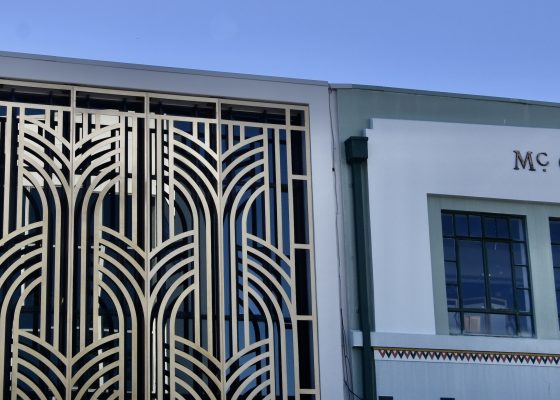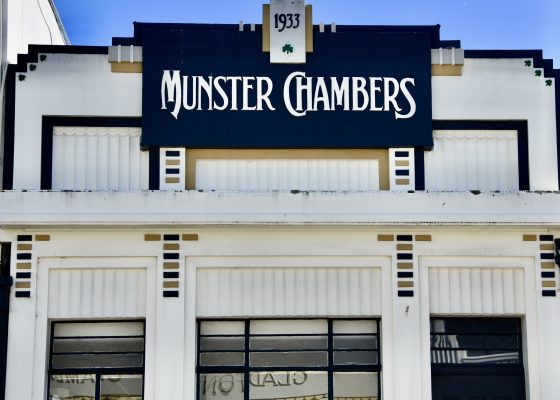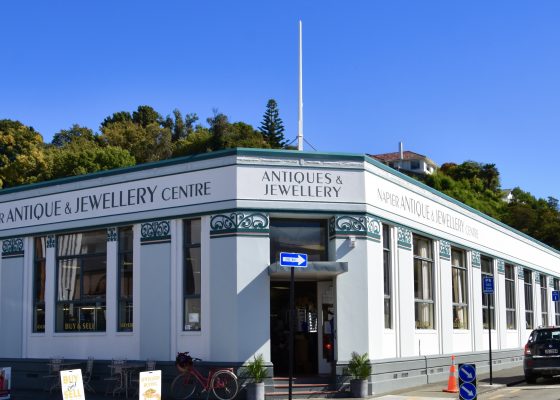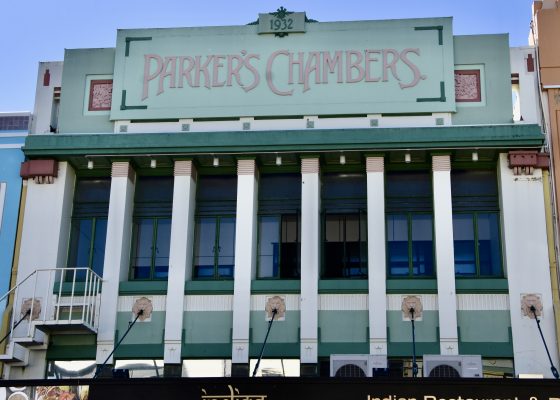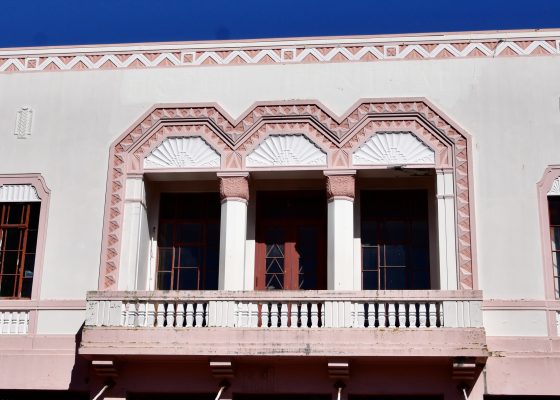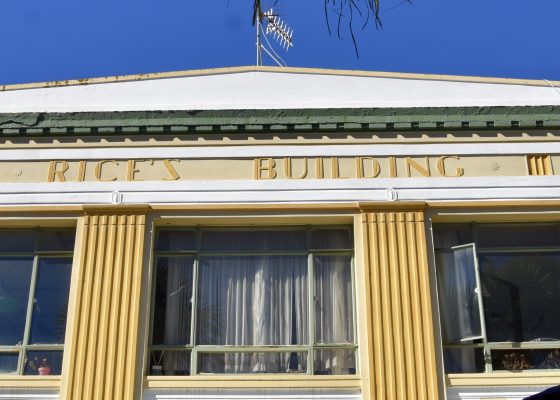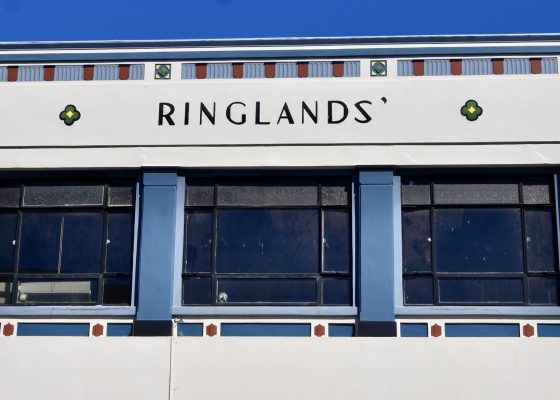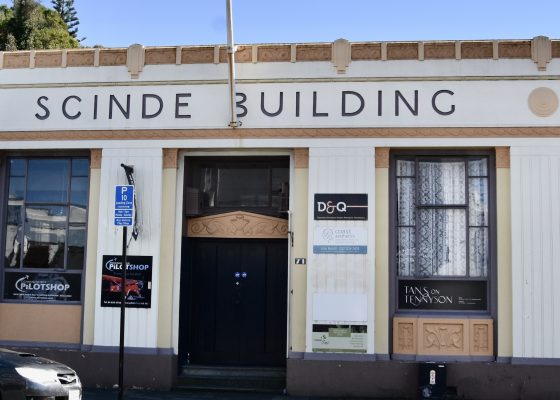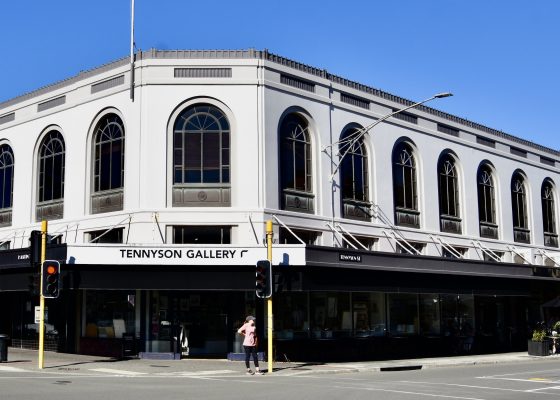Napier – New Zealand’s Art Deco City
In the last post from New Zealand Alison and I said good bye to our Adventures Abroad travelling companions as well as our tour leader and good friend Chris Tripodi as they headed for Australia while we flew to Wellington to continue our tour of the North Island. I described our time in Wellington in this earlier post. In this post we will leave Wellington and head north to the unique city of Napier where we will spend four nights exploring the Hawke’s Bay area including playing a round at one of the top 50 golf courses on the planet. It promises to be a blast and I hope you’ll join us.
Leaving Wellington in the Toyota Corolla we had picked up at the airport, we crossed over from Highway 1, the route we had taken on the AA tour, to Highway 2 which runs up the interior of the North Island until it reaches the Pacific Ocean at Hawke’s Bay. However, before heading straight to Napier I wanted to make one detour.
Cape Pallisser
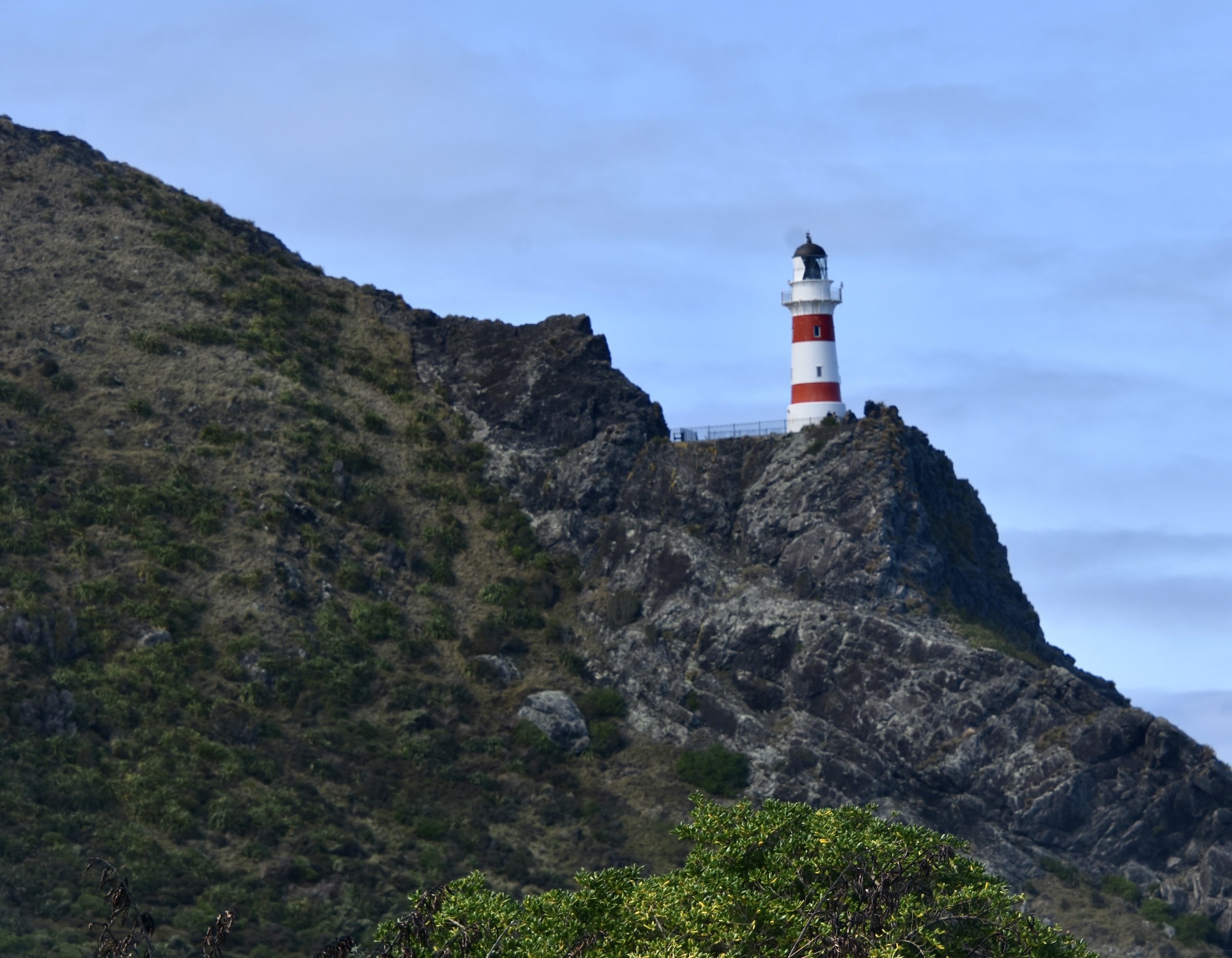
On our first visit to North Island we had taken the long road to the northernmost spot in New Zealand, Cape Reinga to visit its iconic lighthouse. On this visit I wanted to go to the southernmost point on North Island which also features an iconic lighthouse, Cape Pallisser.
Although it’s only 50 kms. (30 miles) from Wellington as the crow flies, by road it’s over twice as far. This area of New Zealand is known as the Wairapapa and it is one of the wildest and least populated areas of the country. The scenery as you reach the coast at the tiny fishing town of Ngawi is spectacular with black volcanic sand beaches and crashing waves.
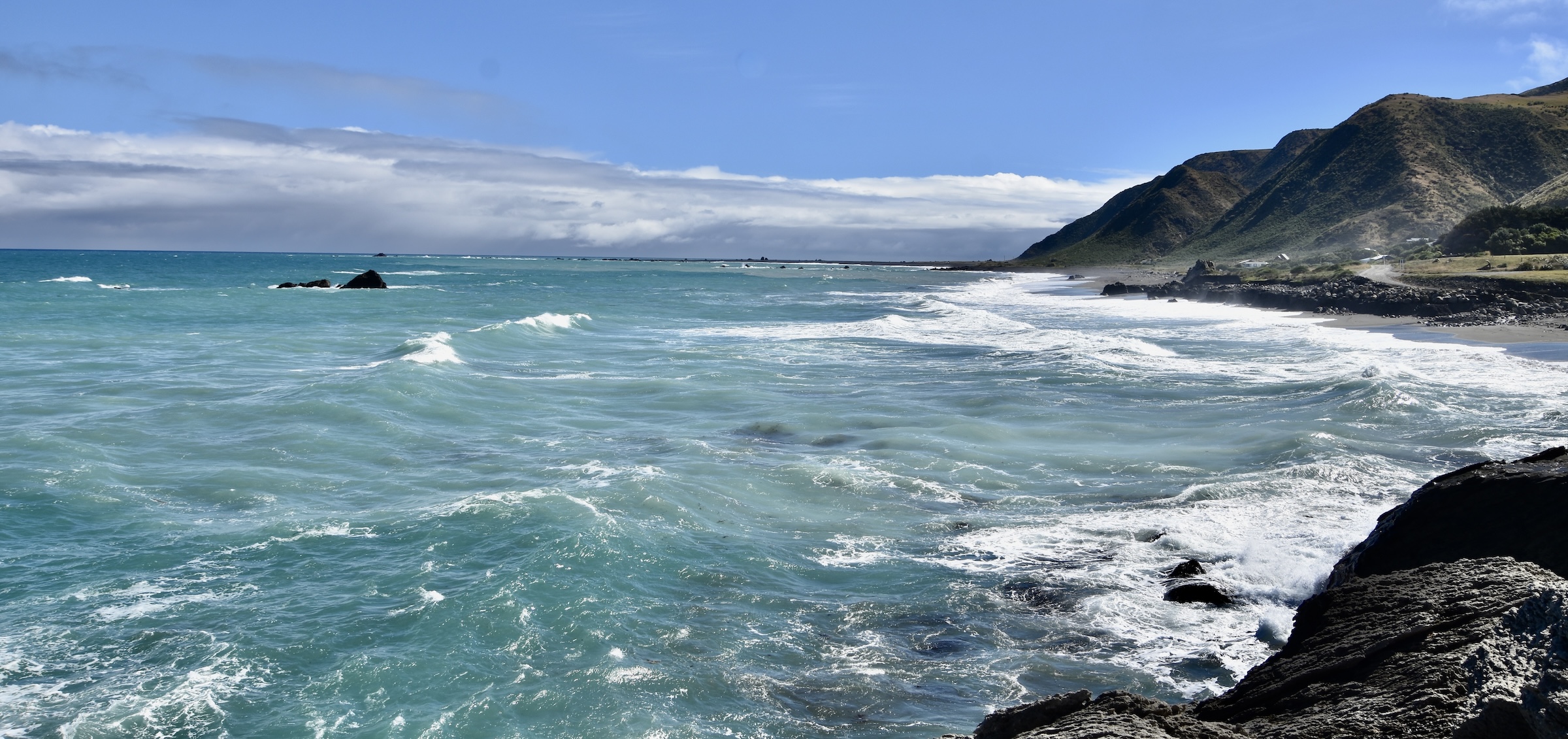
Fur seals are everywhere as this sign attests.
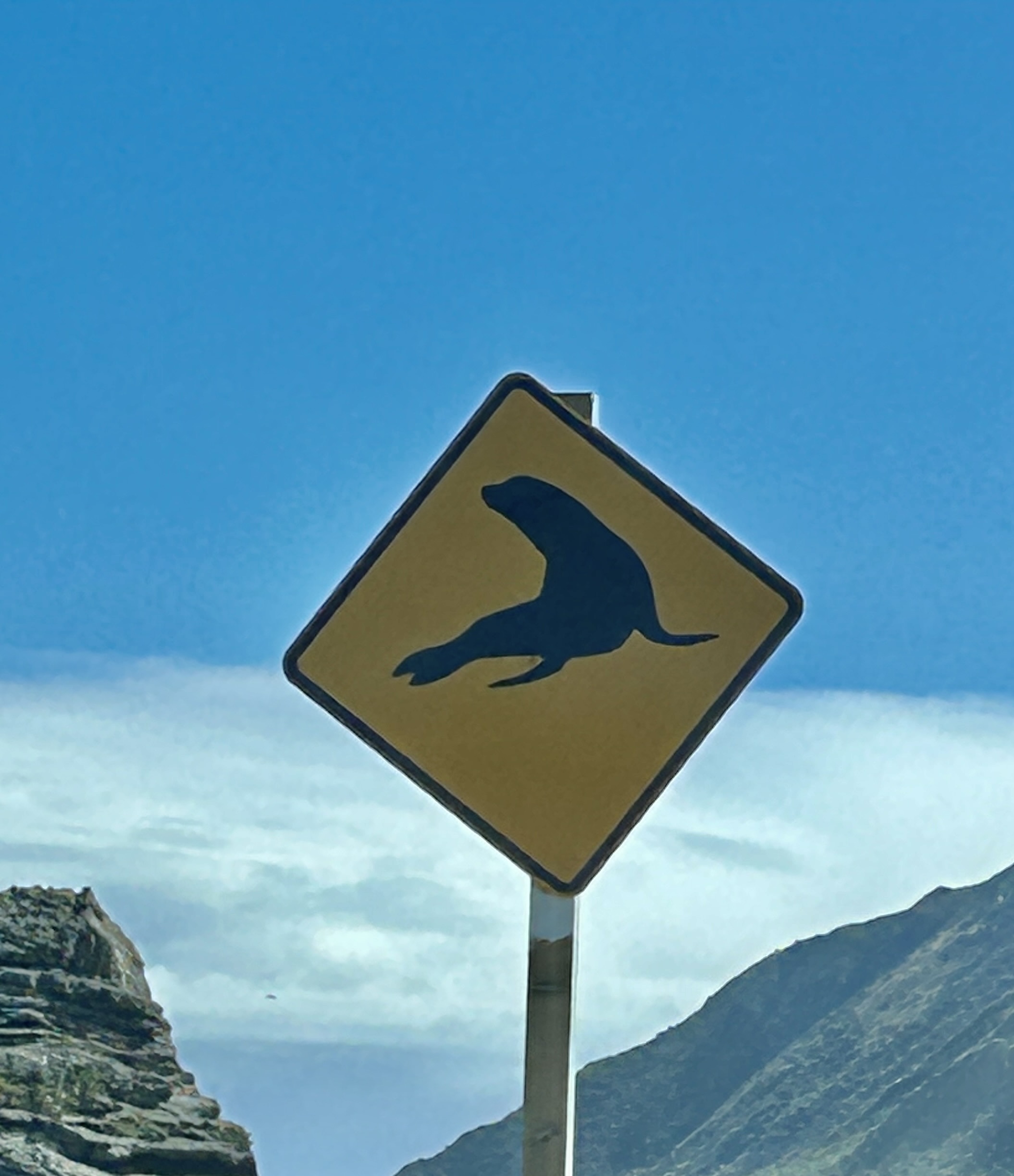
Unfortunately, the road to the lighthouse got progressively worse and in a number of places was almost washed out. Discretion was the better part of valour and I decided not to go any further and limit our view of the lighthouse to the photo above. Still it was another New Zealand lighthouse bagged.
The views on the way back were equally as good as those coming out.
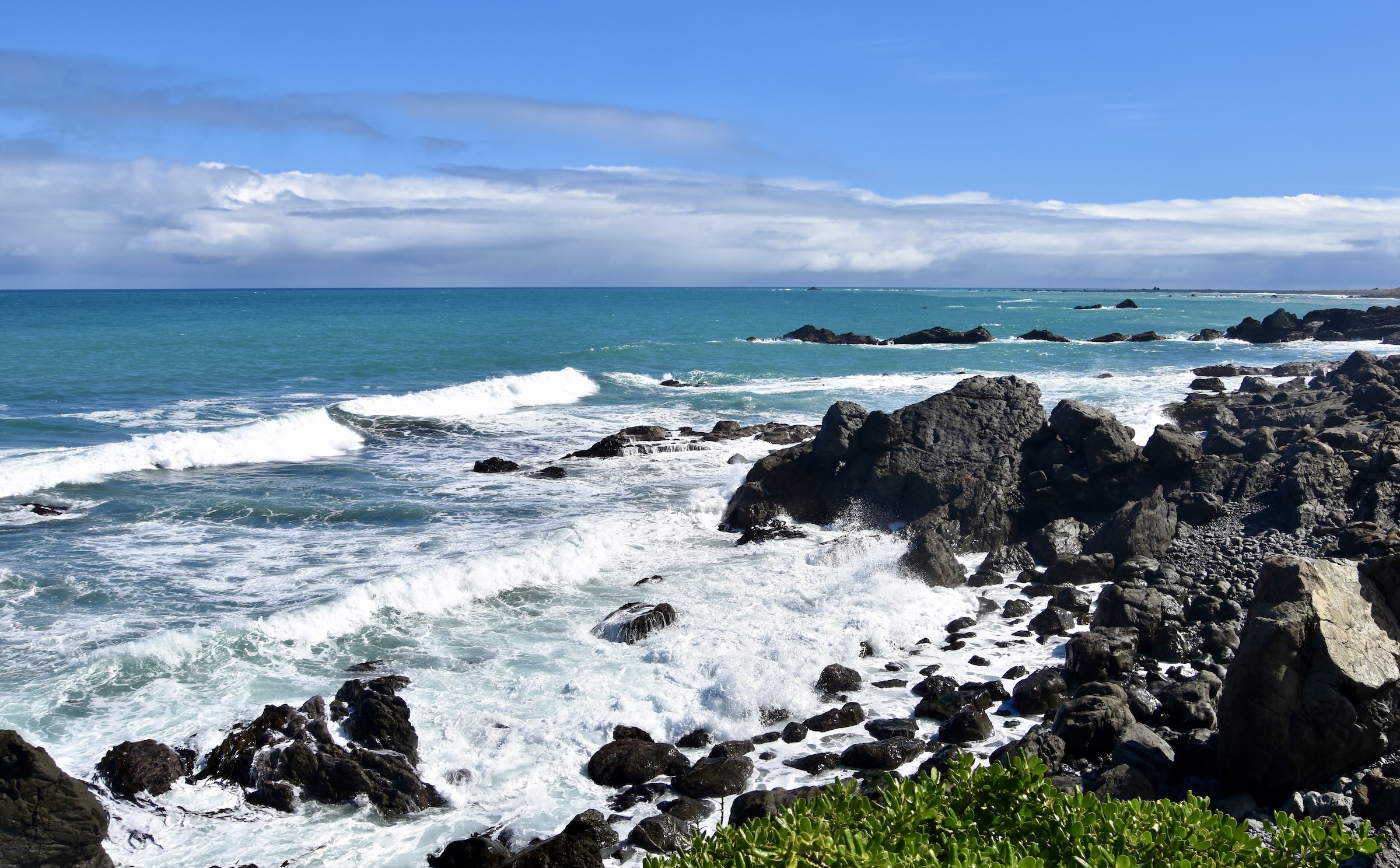
History of Napier

The Hawke’s Bay area of North Island has been known for its great climate, beaches and natural harbour since the first Maori settlers arrived here hundreds of years before Captain Cook sailed in, in 1769 and named it after the then First Lord of the Admiralty, Edward Hawke. The first European settlers arrived around 1830, mostly ex-whalers, missionaries and traders. By 1850 the first farmers were buying land from the Maori. In 1851 the British Crown bought a large block of land on Hawke’s Bay from the Maori iwi who had recognized ownership. As I have noted in previous posts, unlike many Western Hemisphere Indigenous groups, the Maori had a very clear idea of land ownership and the ability to buy and sell it if they wanted to. The land purchase included the site of what became the planned community of Napier, named after Sir Charles Napier, a man who had a truly extraordinary military career that spanned the Napoleonic Wars, the War of 1812 when he was briefly garrisoned in my city of Halifax, Nova Scotia and concluding some 30 years later as Commander-in-Chief of the British army in India. He died in 1853 and when the new town was laid out in 1855, this newly deceased hero of The British Empire, was a suitable candidate to have the place named for him.
Napier and the entire Hawke’s Bay area became the epicentre of the New Zealand wool, meat and fruit export trades. It also proved to be an excellent site for growing grapes and today is New Zealand’s second largest wine production area after Marlborough on South Island. While Marlborough is most famous for its sauvignon blanc wines, Hawke’s Bay wineries specialize in Chardonnay, Pinot Gris and red blends.
Almost from its inception Napier was a magnet for tourists drawn by its excellent climate, great beaches and dramatic scenery in places like Te Mata from where on a clear day you get a view like this. We did take the drive up, but unfortunately it was fogged in, but it does have a nice restaurant at the top.

All was going great for Napier and its twin city Hastings, until the morning of February 3, 1931 when a massive earthquake struck and literally flattened the city, killing 256 people outright and injuring thousands. It was the worst natural disaster in New Zealand’s history.
The city was rebuilt in the architectural style that was at its height in the early 1930’s, Art Deco. The first Art Deco buildings appeared in Paris just before WWI, but really took hold in the 1920’s when the term Art Deco was coined during the 1925 Artes Décoratifs exposition in Paris. The epitome of Art Deco buildings are the Empire State and Chrysler buildings in New York and the world’s largest collection of Art Deco buildings in Miami Beach that got started after a 1926 hurricane wiped away the flimsy structures that preceded them.
Years ago Alison and I attended one of the annual Art Deco Weekends held in January in Miami Beach and really became fans not only of the architecture, but also the whole Art Deco culture that includes fashion, design and frankly, luxury. So when I was doing my research on New Zealand and learned about Napier and its Art Deco connection, I knew we had to see it.
Driving into Napier from the south you pass first through Hastings which is an inland city that is overshadowed by its more glamorous neighbour, before reaching the ocean at the in between community of Clive. From here the entrance to Napier is one of the nicest approaches to a city you will find anywhere as the highway follows the course of the Marine Parade, a 3 km. promenade with the beach on one side and century old Norfolk pines on the other. It is best appreciated by viewing it from above as in this photo.
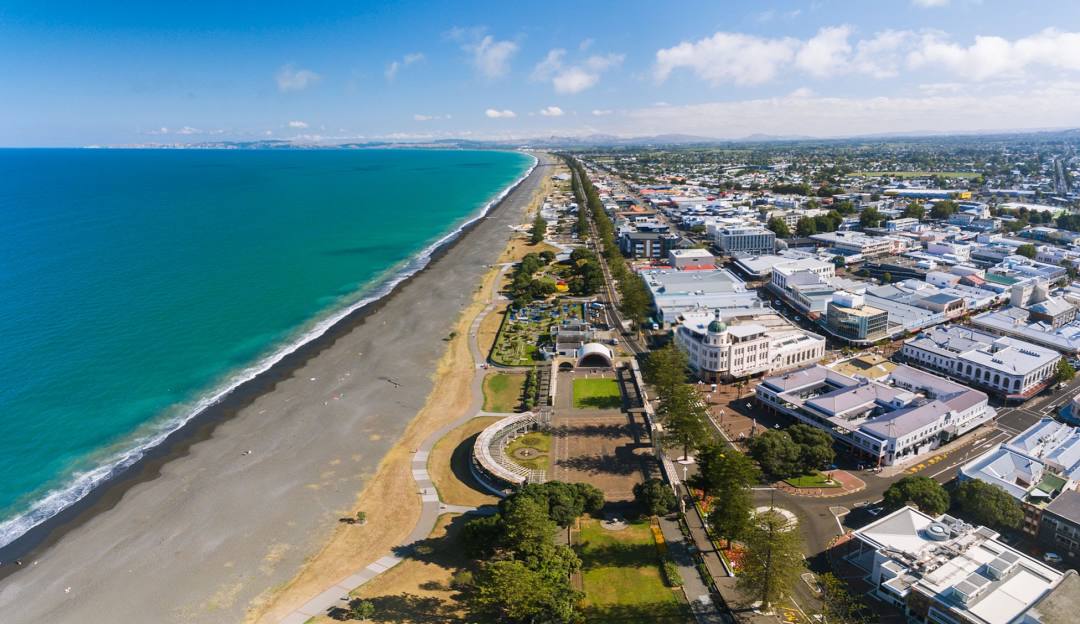
The route is lined with motels, guest houses, shops and restaurants and that’s where we will make our first stop.
Motel de la Mer
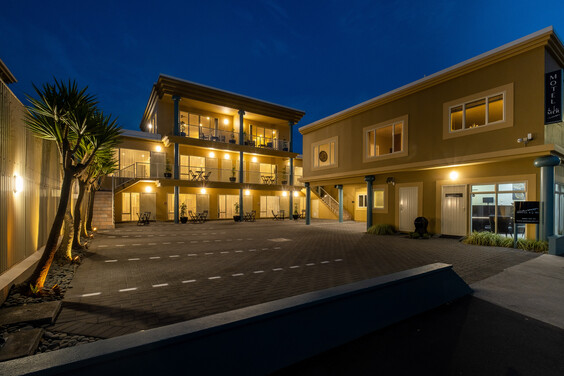
As on our first trip to North Island, we had enlisted the services of Cheryl Bailie of North Vancouver’s New Zealand Golf & Wine Tours to select our accommodations and once again she came through like a pro. Motel de la Mer is directly on the Marine Parade and within easy walking distance of the Art Deco district which has limited accommodation. Originally we were booked into a room on the ground floor, but upon checking in, the proprietor told us that since one of the penthouse suites was not booked, she was moving us up there at no extra charge.
The suite was really a large apartment with tons of room.
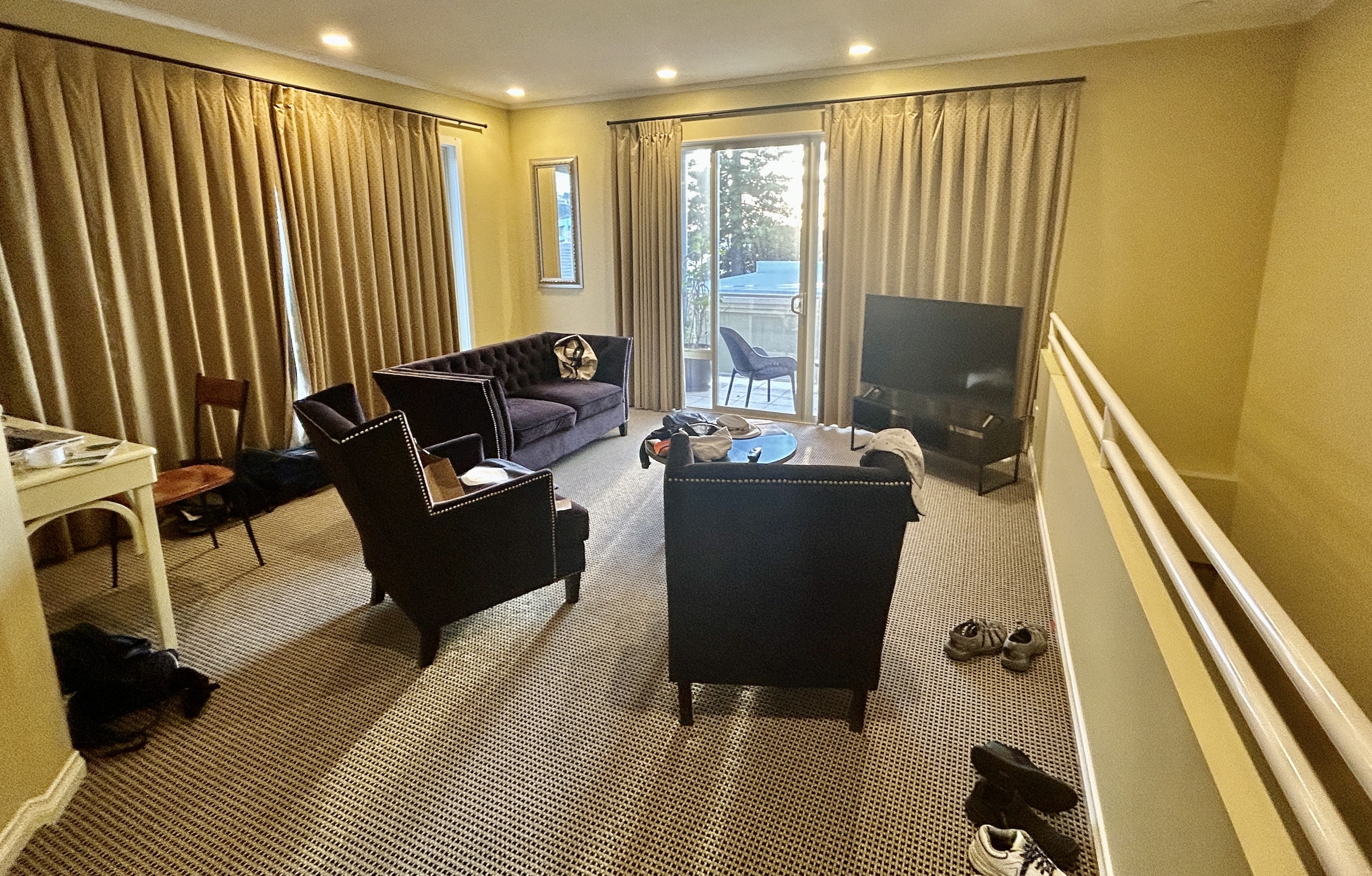
And this view from the balcony.
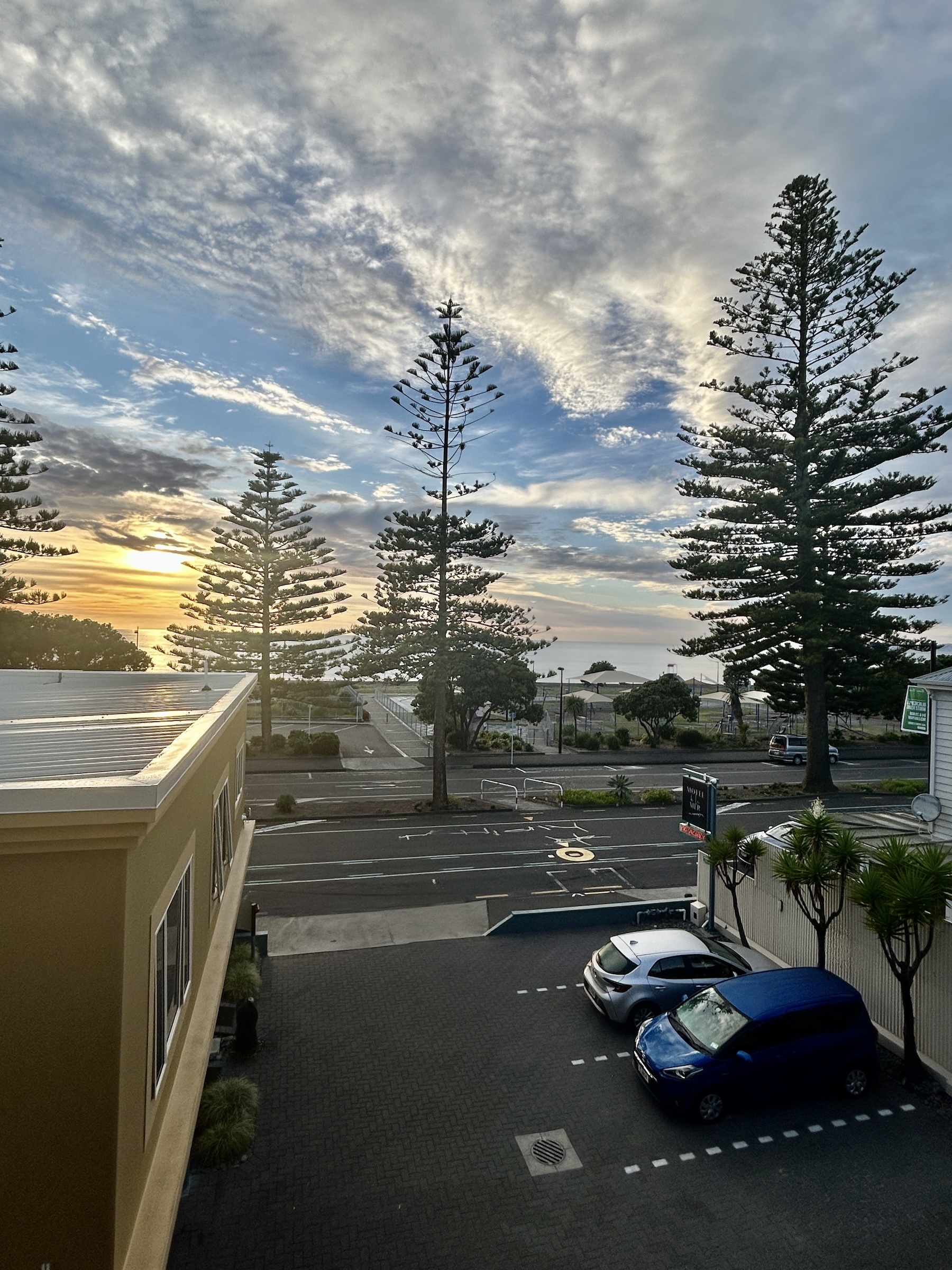
Another bonus was that the motel has a free laundry room.
So we’ve found ourselves a great place to staying in Napier, so now let’s start checking out the place.
The Art Deco District
The best way to take in Napier’s Art Deco District is to take a guided walking tour led by one of the Art Deco Trust volunteers. We booked a 10:00 AM tour at the Napier Visitor Information Centre which starts at the Art Deco Centre just across the street where you’ll encounter this icon of 1920’s fashion.
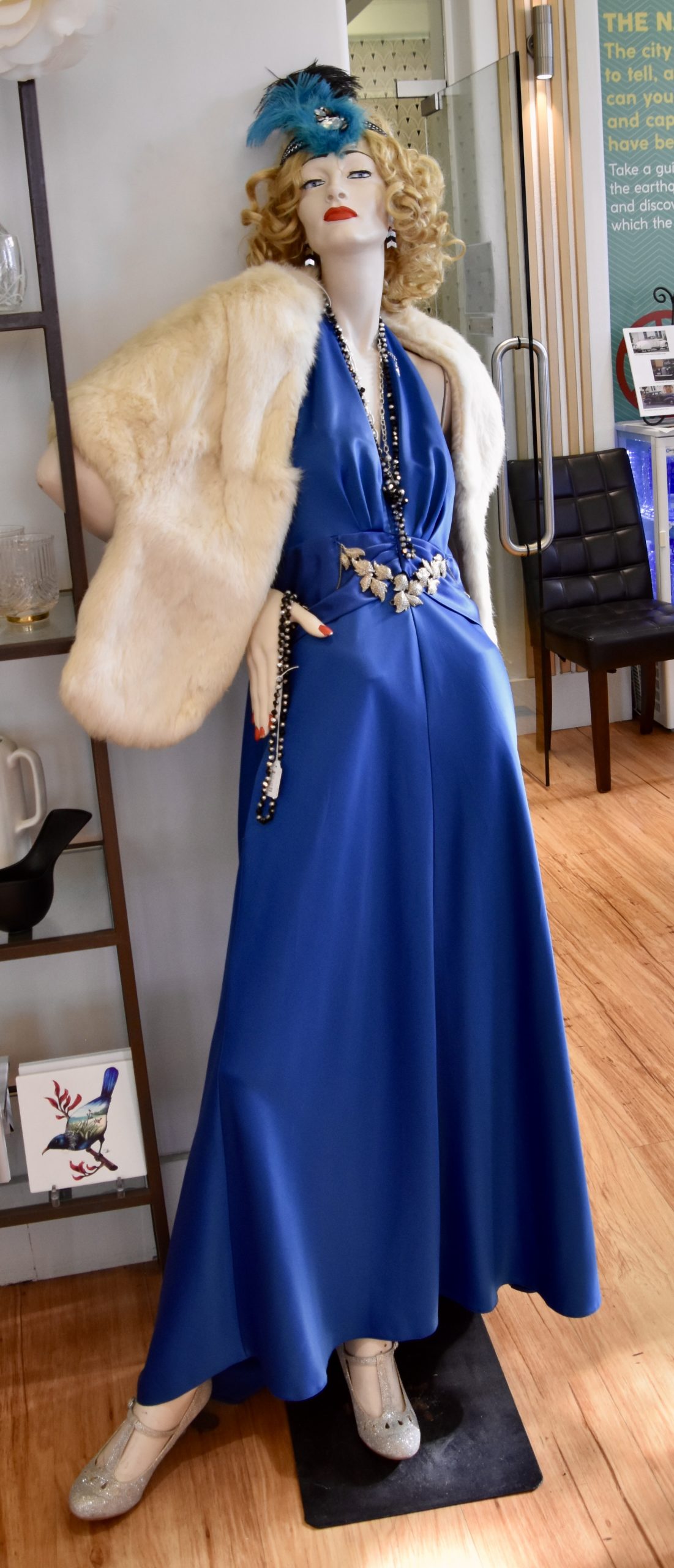
Not to be outdone, we donned our own outfits, suitable for a sashay around the streets of Napier.
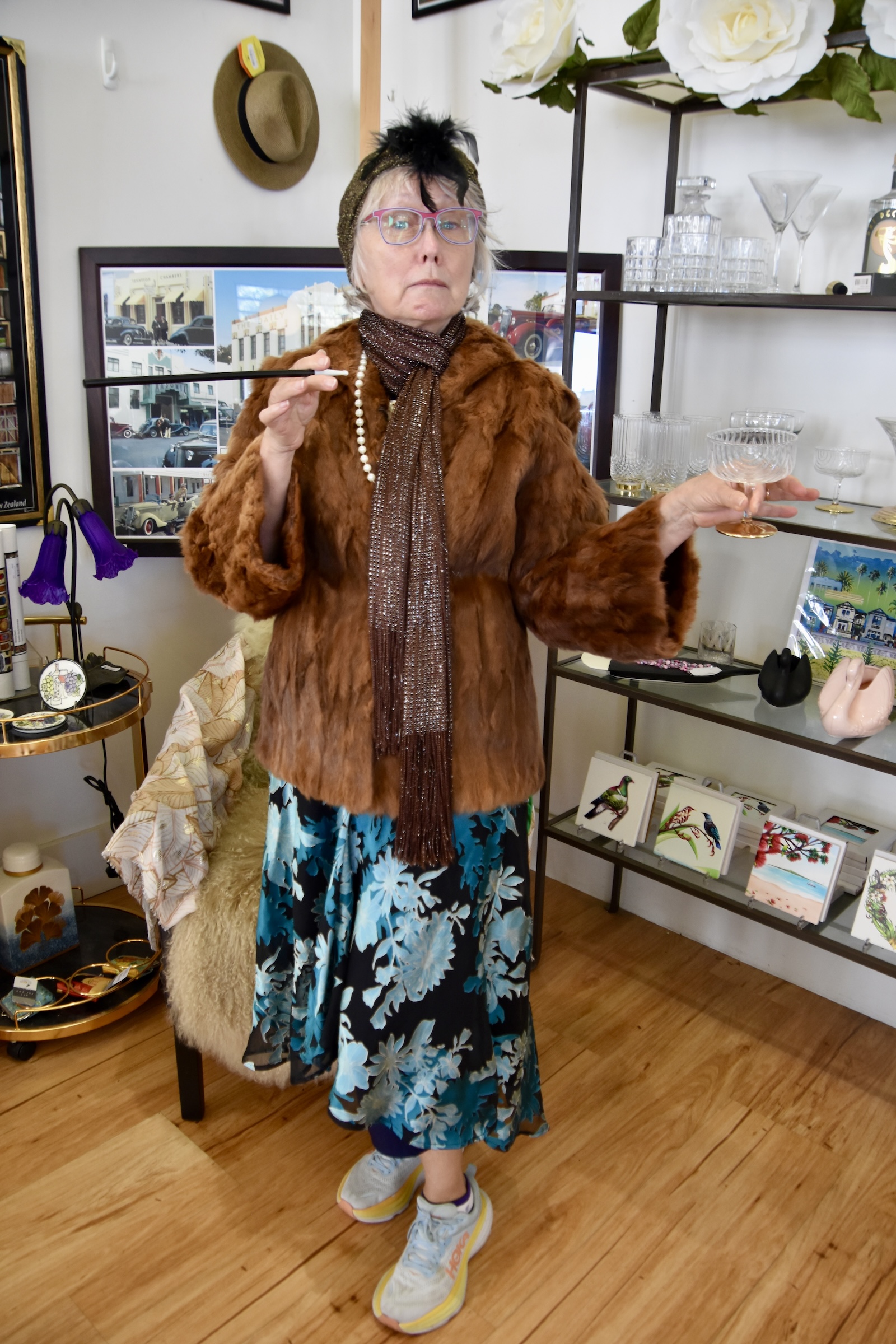
And mine.
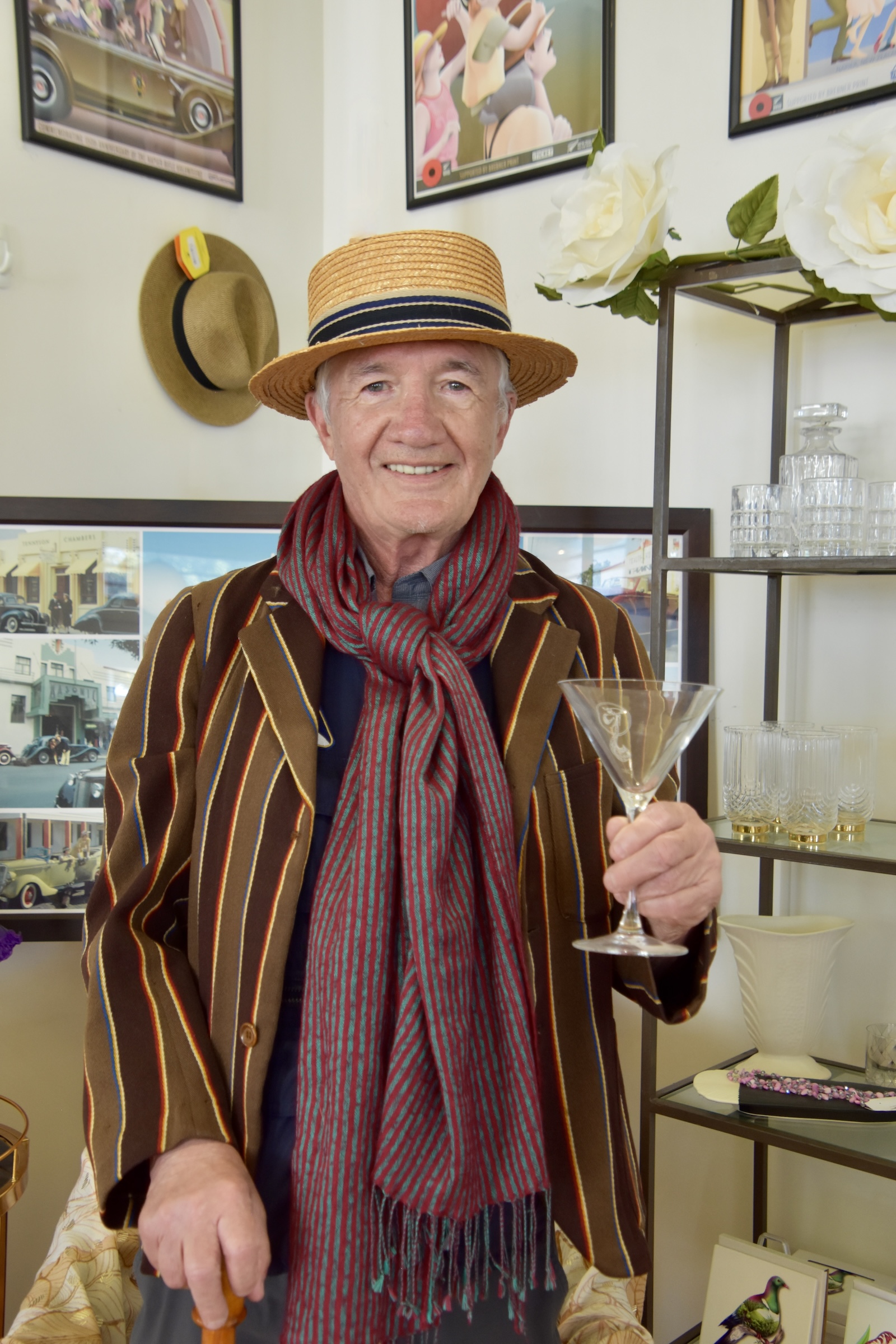
The guided tour lasts 1.5 hours and takes in too many notable buildings to dwell on in this post, so I’ll feature a few and then the rest in a gallery.
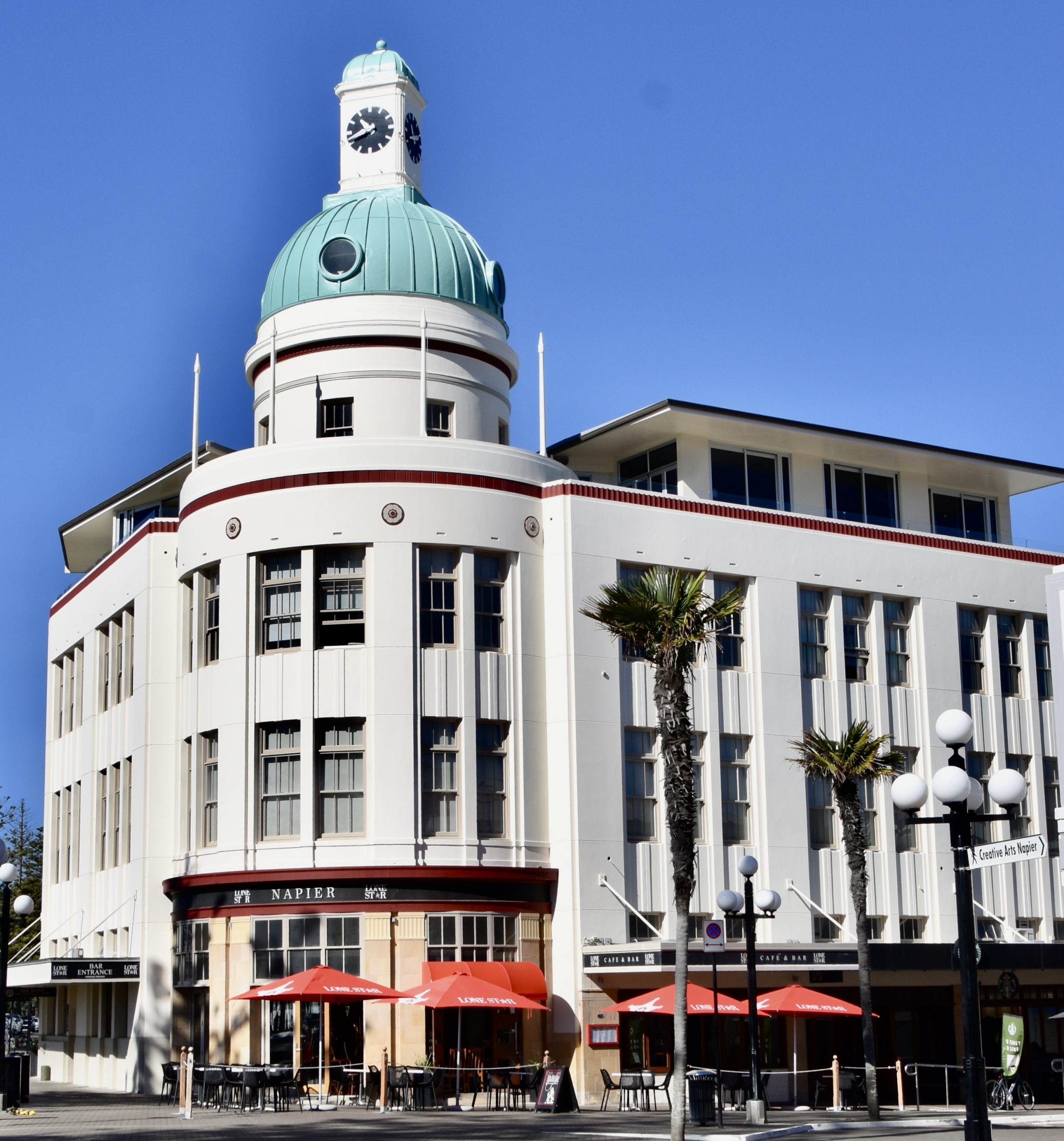
This building is the probably the one most photographed in Napier and most representative of the Art Deco Streamline Moderne genre that emerged in the 1930s that features curved aerodynamic lines. The word ‘sleek’ is an adjective often attached to this style of design. Originally built for the Temperance General Insurance Company in 1935 it is now The Dome boutique hotel and contrary to the builder’s wishes, you can have a cocktail or two here.
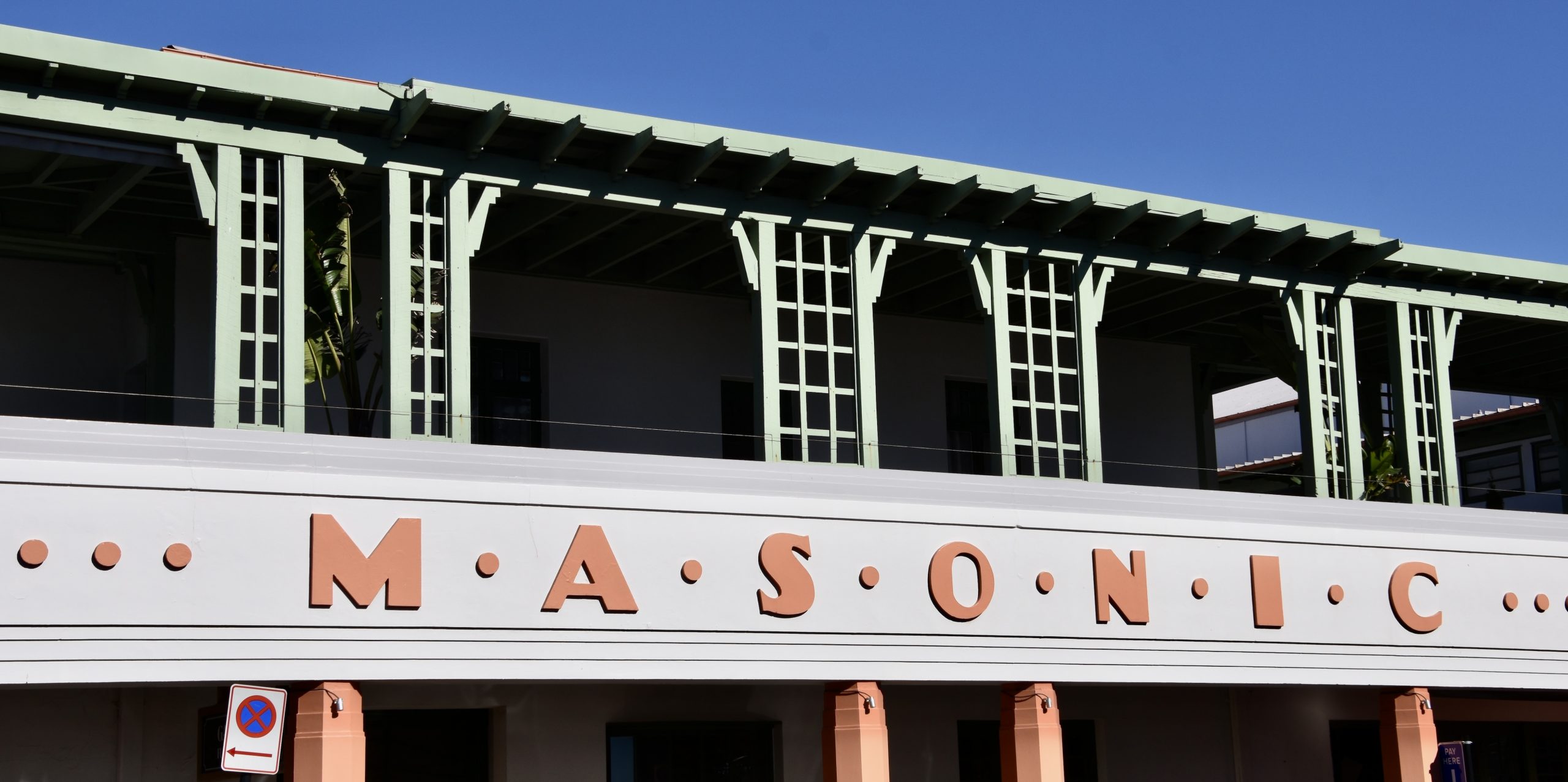
Just down Tennyson Street is the Masonic Hotel which is the third version on the same site. If you’ve got the bucks you can go through this entrance and stay at the Mark Twain suite. The famous author stayed at the first version in 1895 which burnt down a year later.
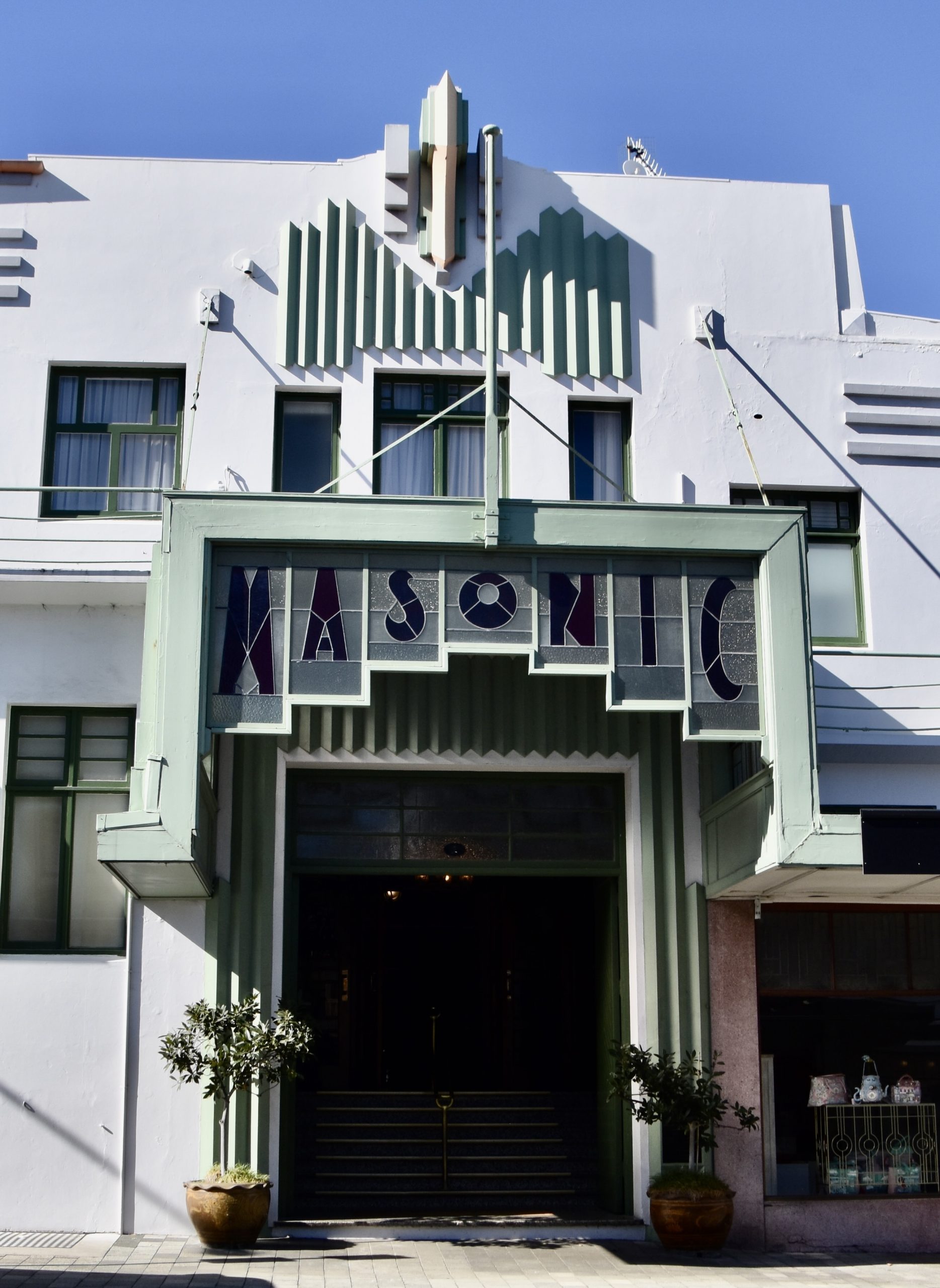
The Australian Mutual Provident Society building, which dates from 1935, is an example of the Chicago or Prairie style of architecture which is most famously associated with Frank Lloyd Wright. Only months before this trip, Alison and I visited Wright’s studio in suburban Oak Park, Illinois which I had first written about way back in 2014.
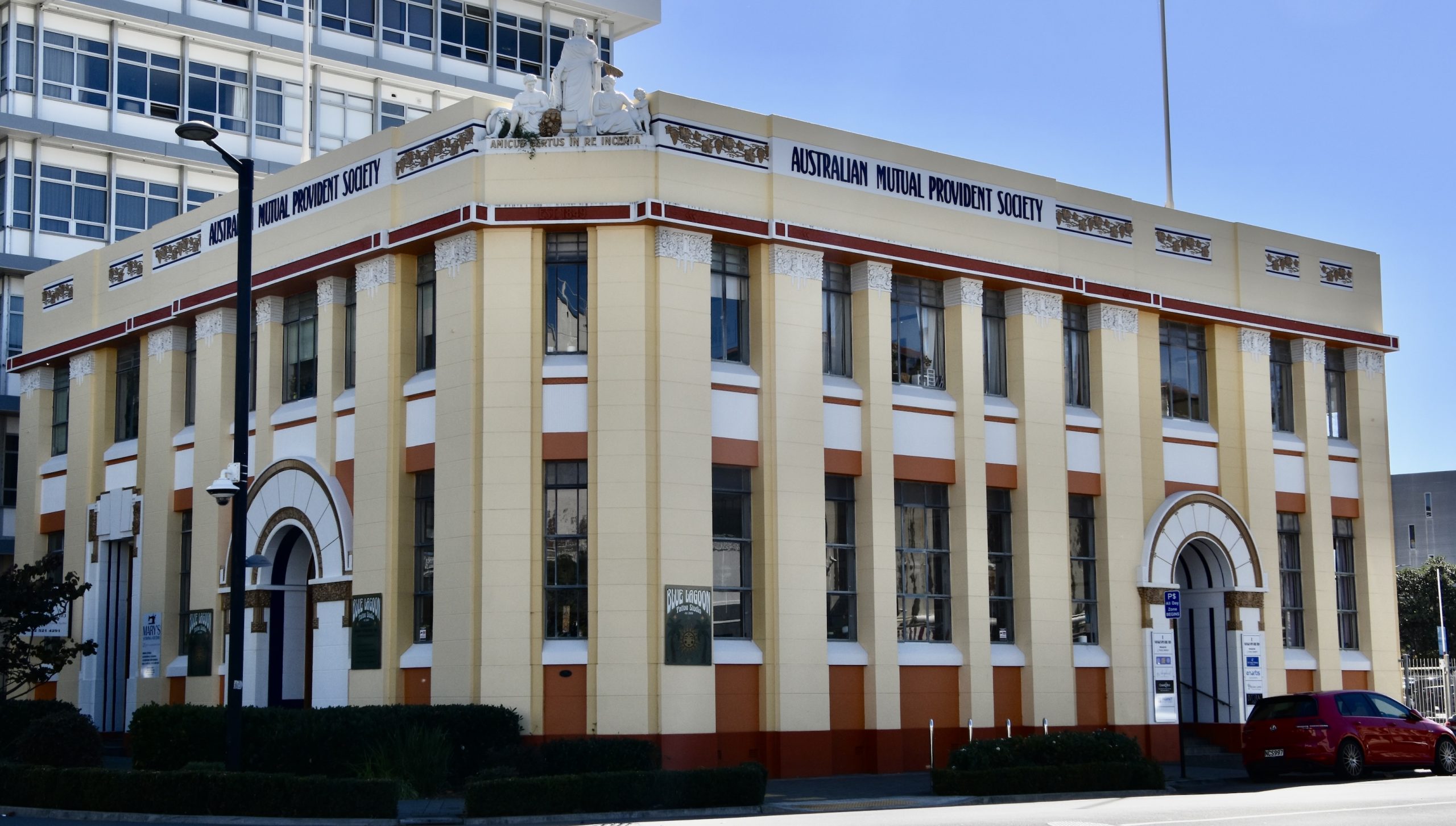
Perhaps my favourite building in the Napier Art Deco District was the Daily Telegraph building. Completed in 1932, it is the epitome of Art Deco architecture.
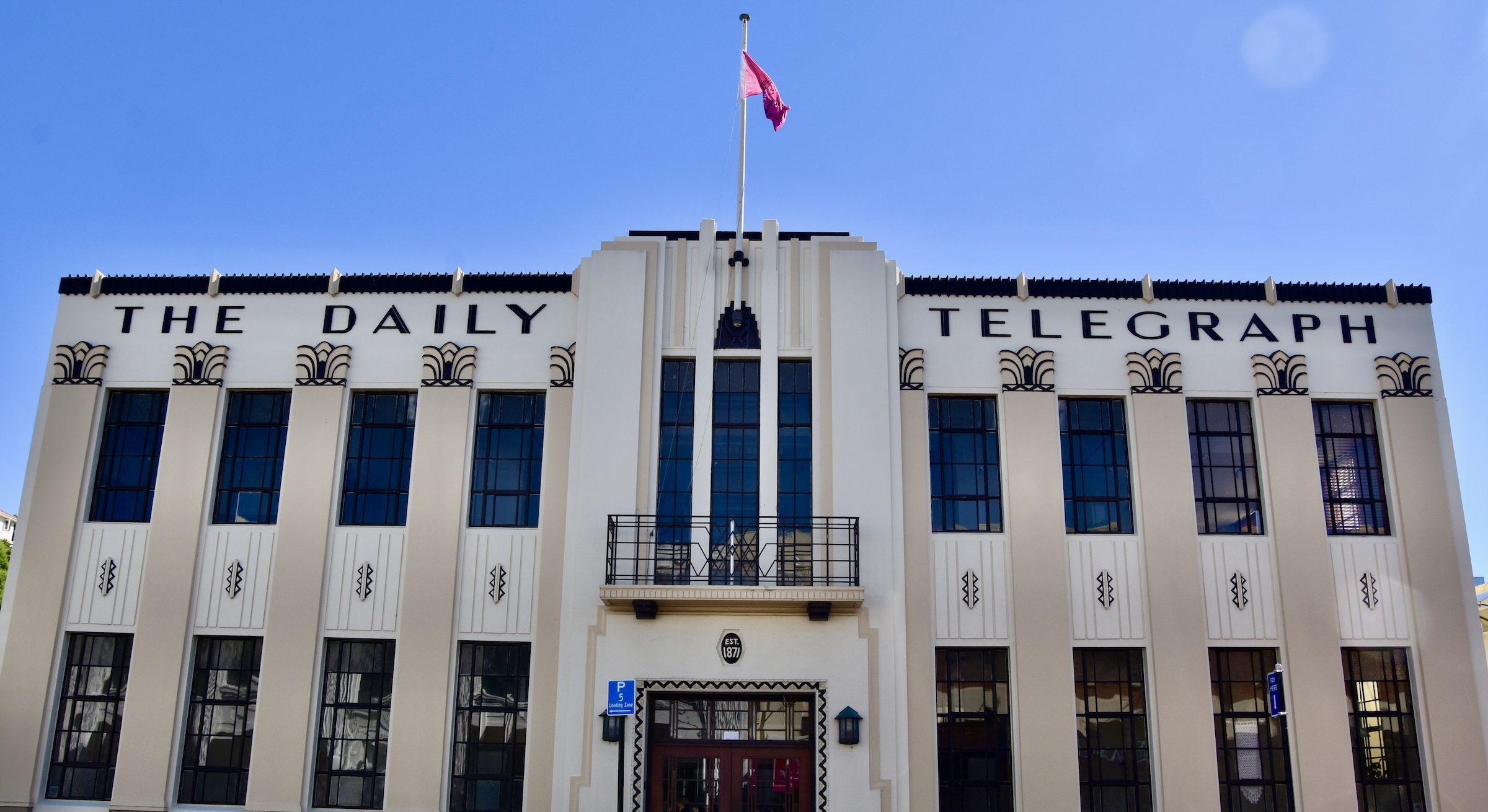
While the Miami Beach Art Deco hotels are indeed impressive and worthy of the praise heaped upon them, the Napier Art Deco district has a completely different vibe which is equally as impressive in my mind. The scale is much smaller than Miami Beach and the businesses that erected these buildings much more diverse. You do get a sense of a community coming together with a sense of resurrection and civic spirit that comes through in these buildings.
Here is a gallery of Napier Art Deco architecture that features some of the best of the rest. Double click to open and double click again to enlarge.
Not all the buildings that were destroyed in the 1931 earthquake were replaced as quickly the ones featured above. The Cathedral of St. John took over forty years to be reconsecrated.
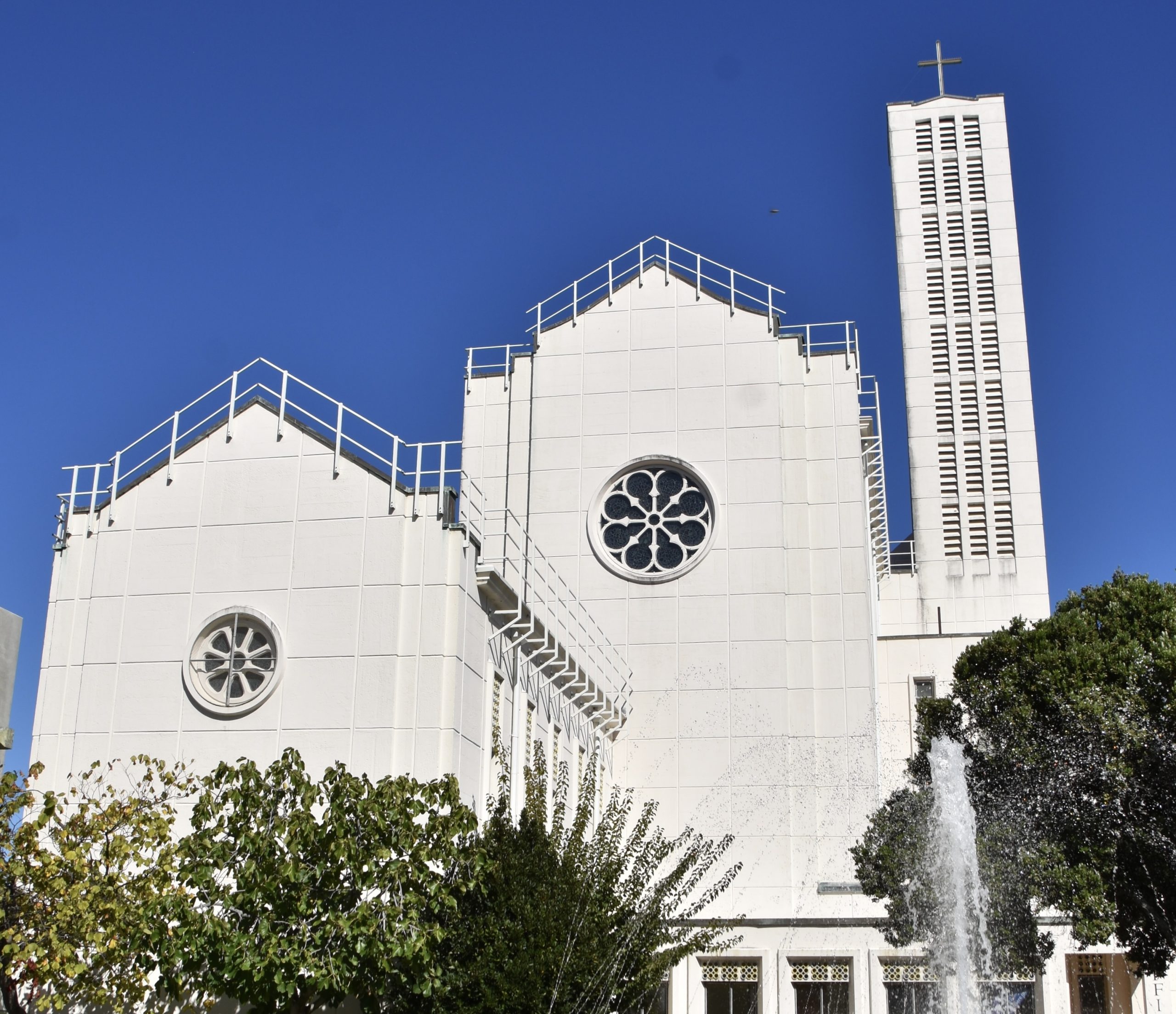
There is one building in Napier’s Central Business District that is distinctly not Art Deco and that is the neo-classical Public Trust Building, one of the very few to survive the 1931 earthquake.
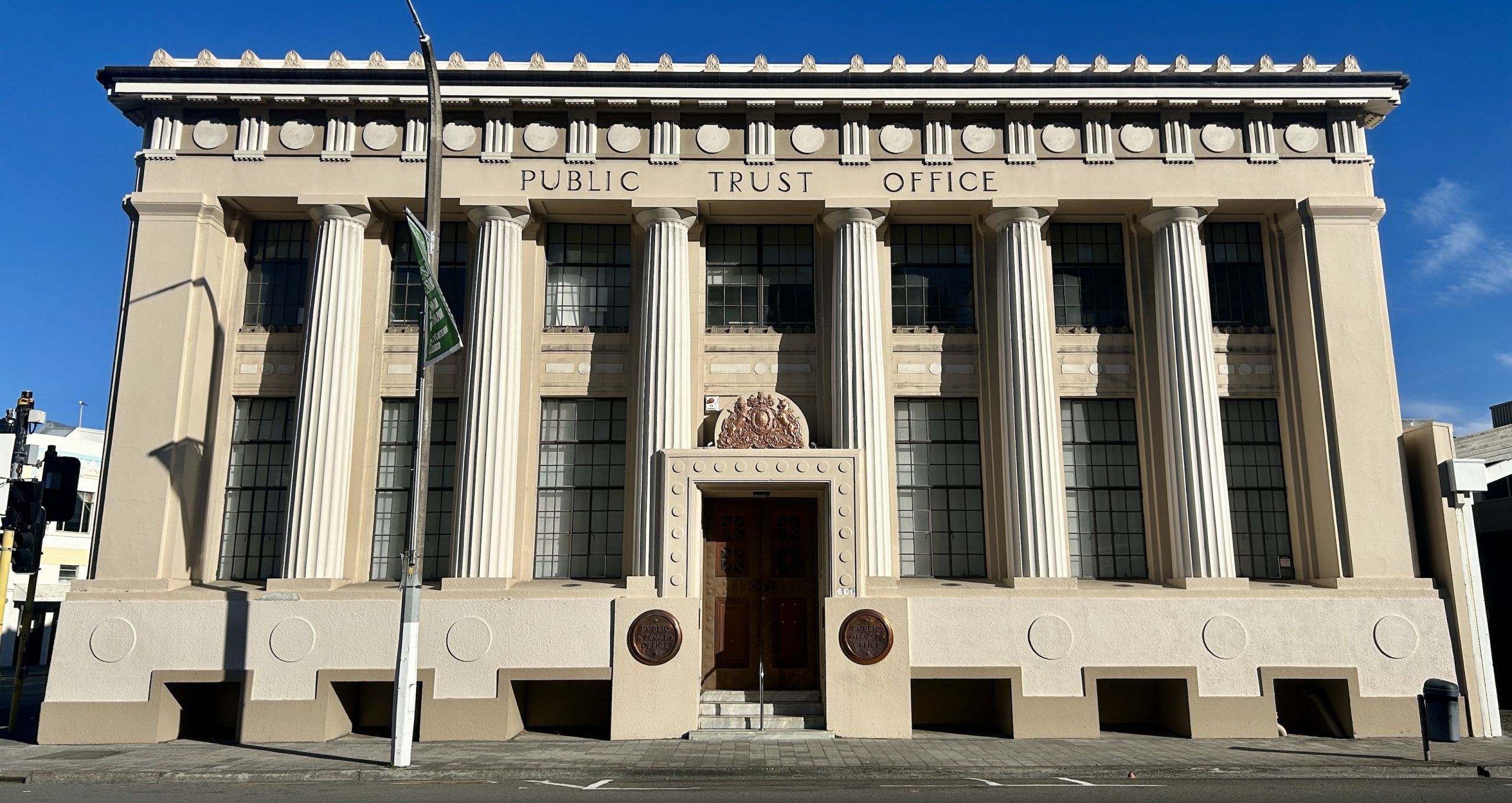
Here is a photo of that building still standing amid the rubble all around.
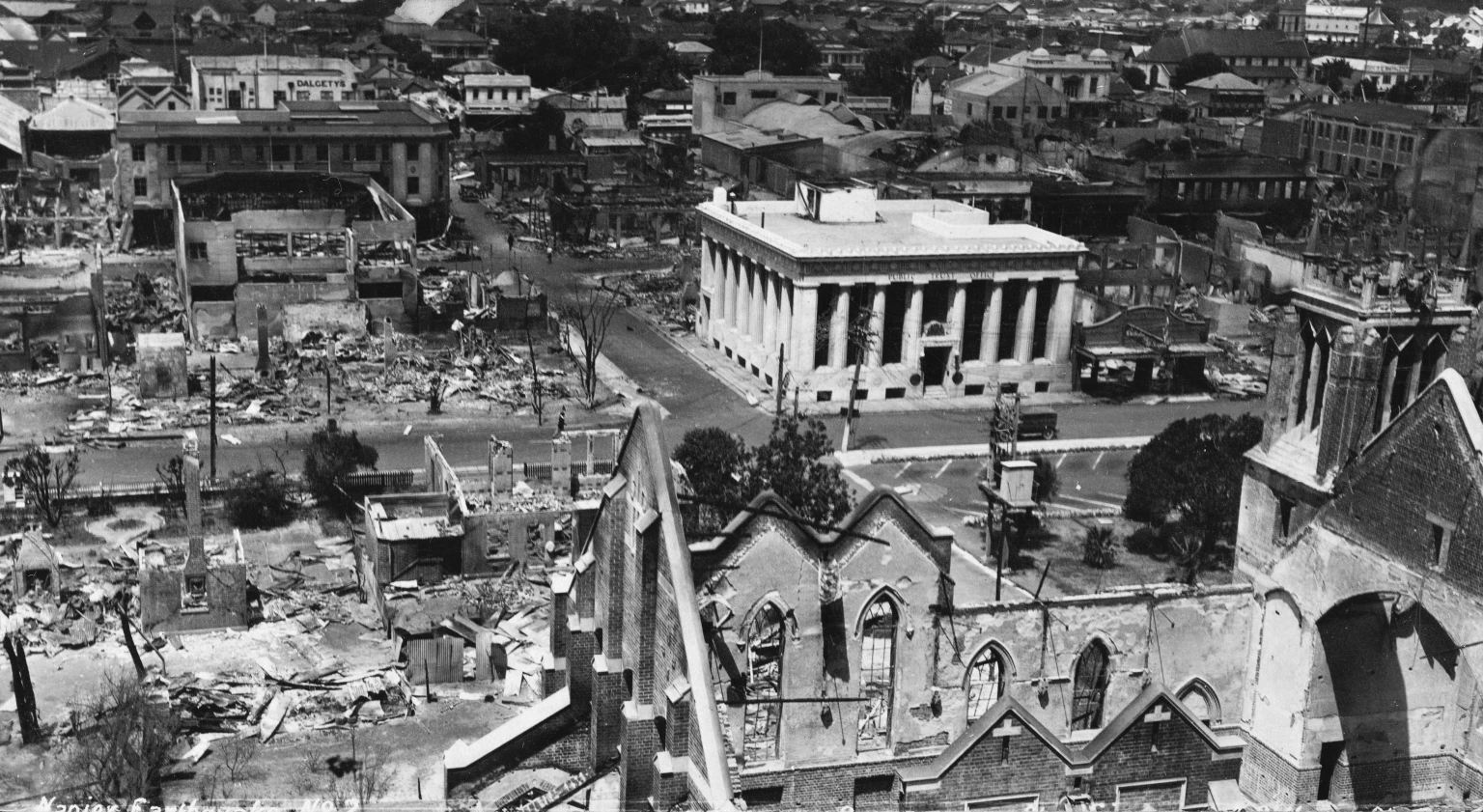
There are many other interesting things to see on a walk around Napier, most on or near the Marine Parade which you enter through this archway which was erected in 1937 to commemorate the city’s revival from the earthquake.
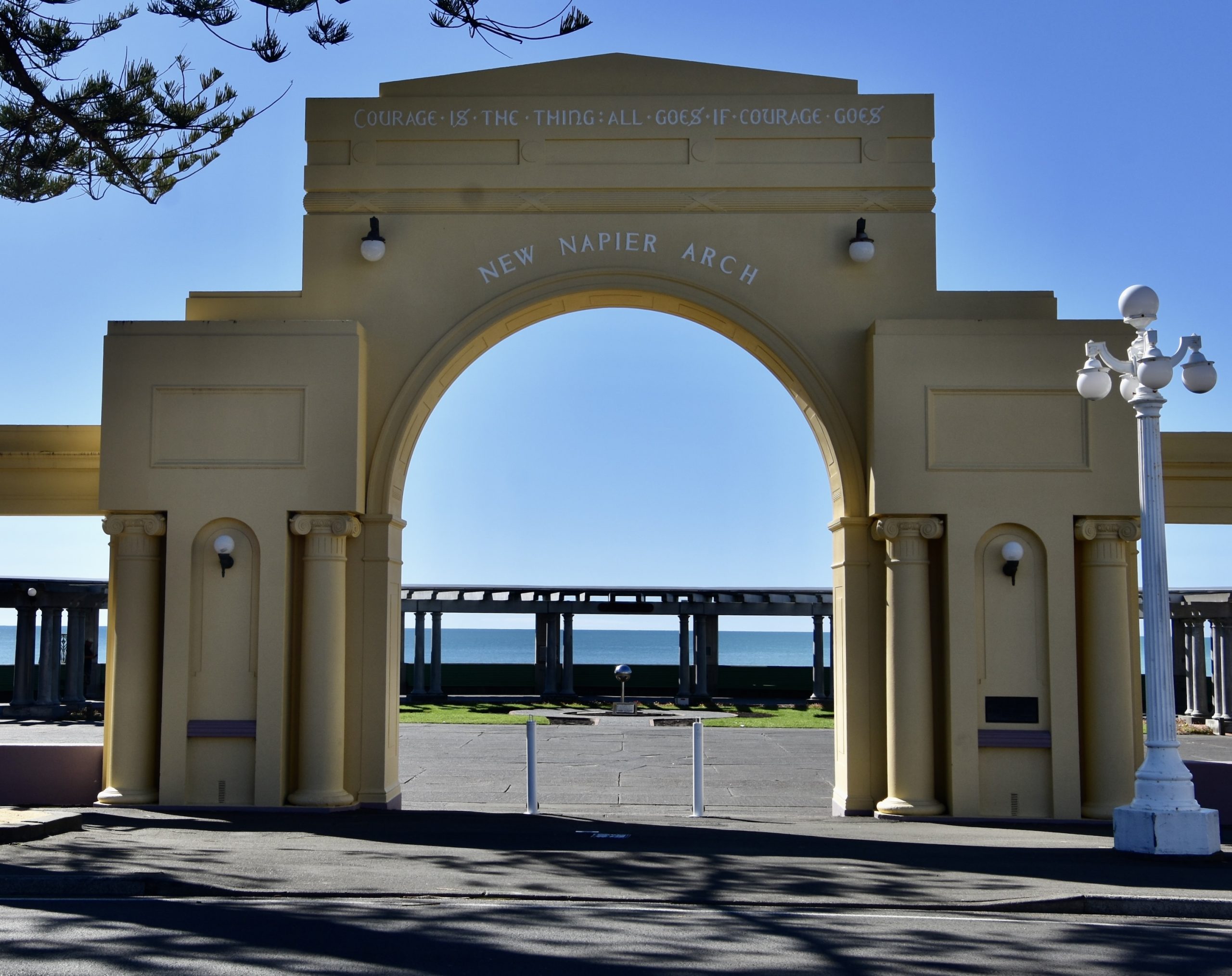
There are several prominent gardens along the Marine Parade of which this dahlia garden is outstanding.

There are also a number of striking sculptures along the Marine Parade including Spirit of Napier featured at the head of this post and the Gold of the Kowhai by Paul Dibble that portrays the flower of the kowhai tree that is endemic to New Zealand.
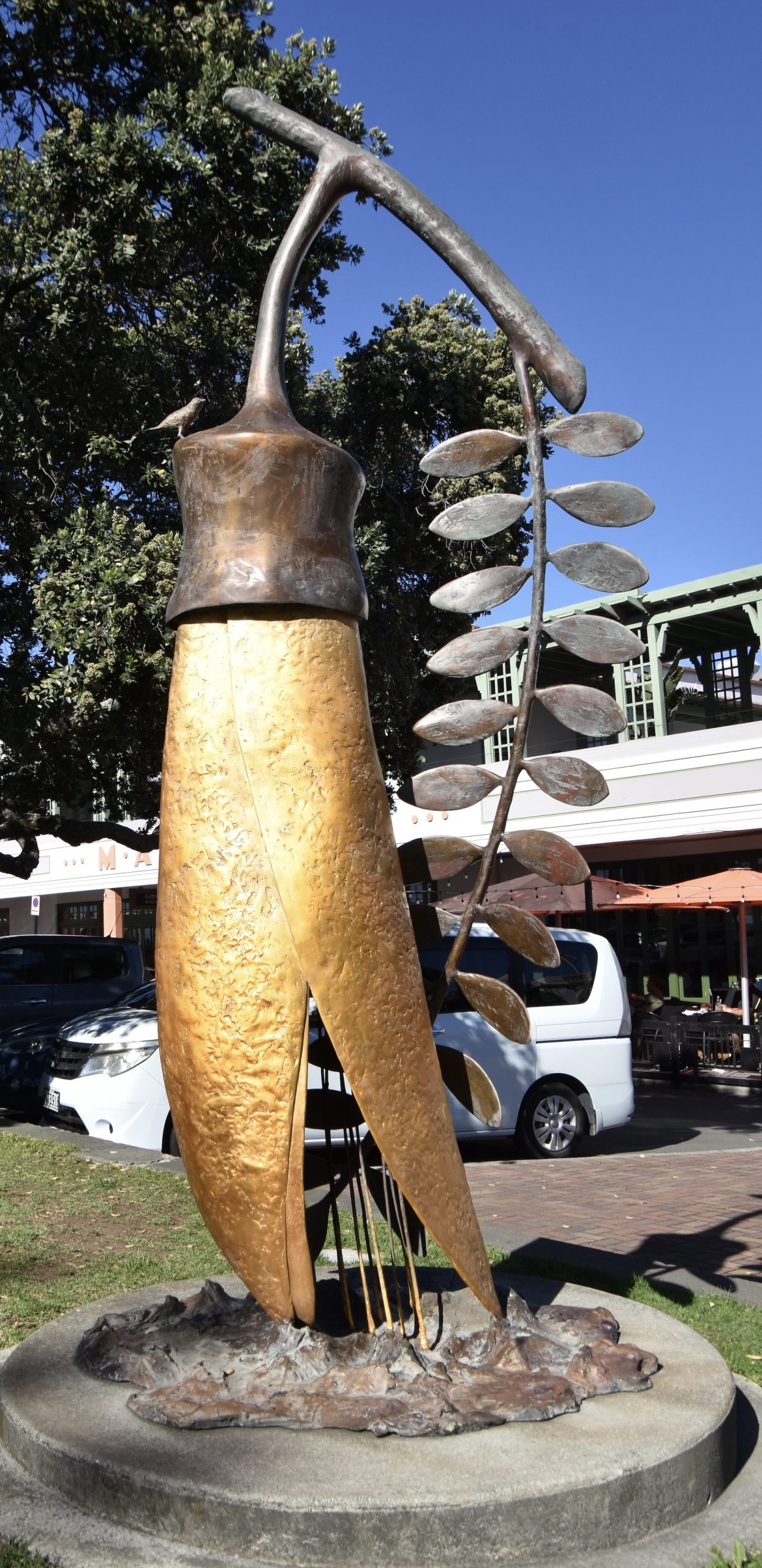
However, the sculpture everyone comes to see in Napier is this one.
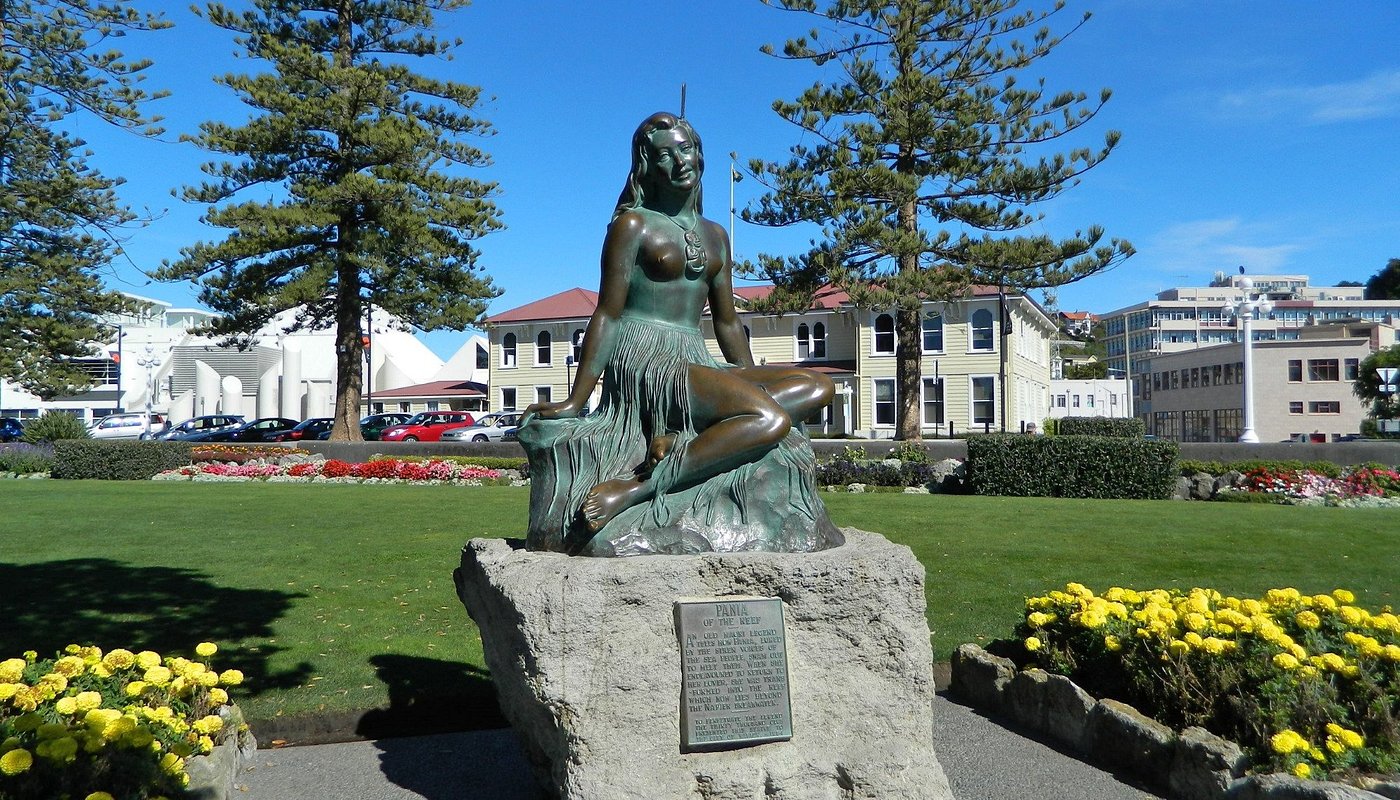
This is Pania of the Reef, a mythological Maori sea-woman who fell in love with a mortal man and was transformed into a reef by the sea god Moana-nui-a-kiwa, who didn’t like his subjects mixing with mere human beings. It was unveiled in 1954 and was modelled after a real Maori woman who only died in 2024. The statue is often likened to Copenhagen’s Little Mermaid, both for its symbolic significance of the connection between earth and sea and for its turbulent history. Like the Little Mermaid, Pania has been stolen and vandalized, but has survived and today is probably the most famous statue in New Zealand.
Also on the Marine Parade you will find the National Aquarium of New Zealand. While it’s not as large and impressive as many aquariums Alison and I have visited, it is definitely worth a visit to see three things, of which only two are aquatic related.
The first is the little penguin pool at feeding time. We first saw these birds in the stuffed edition at the Russell Museum at the very beginning of this trip and then a live version on the Otago Peninsula. Here at the aquarium you can get a much better look at them and appreciate how tiny they really are.
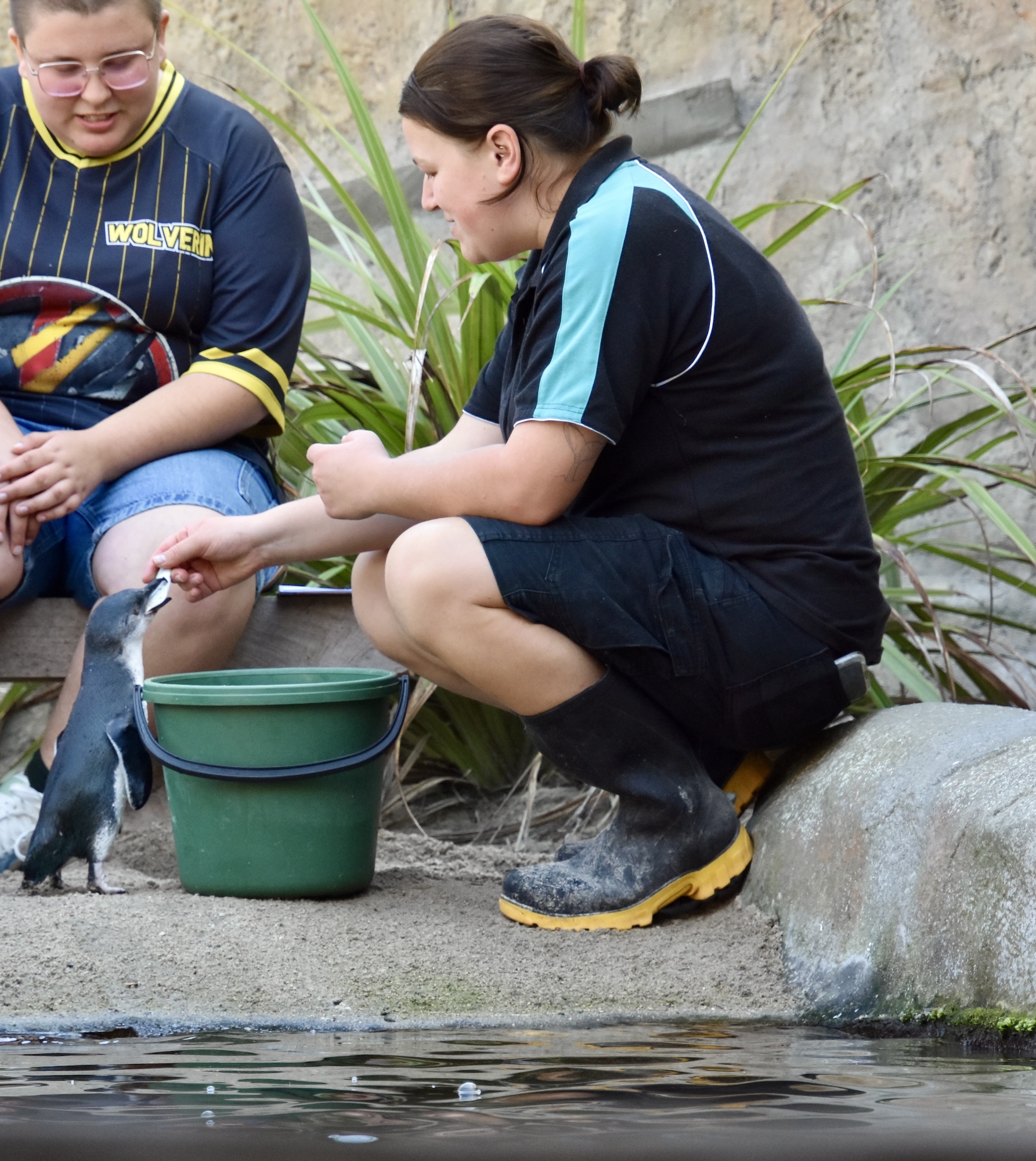
The second is to see a tuatara, that is the only species left of hundreds that were once the dominant reptiles in the world 240 million years ago. Like many New Zealand species they were wiped out on the two main islands by rats and other human introduced predators and only survived on a few smaller islands. They were successfully introduced to the mainland once again at Zealandia which we visited earlier on this trip, but seeing one in the wild is next to impossible.
So seeing one the rarest animals on earth is more than enough reason to visit the aquarium.
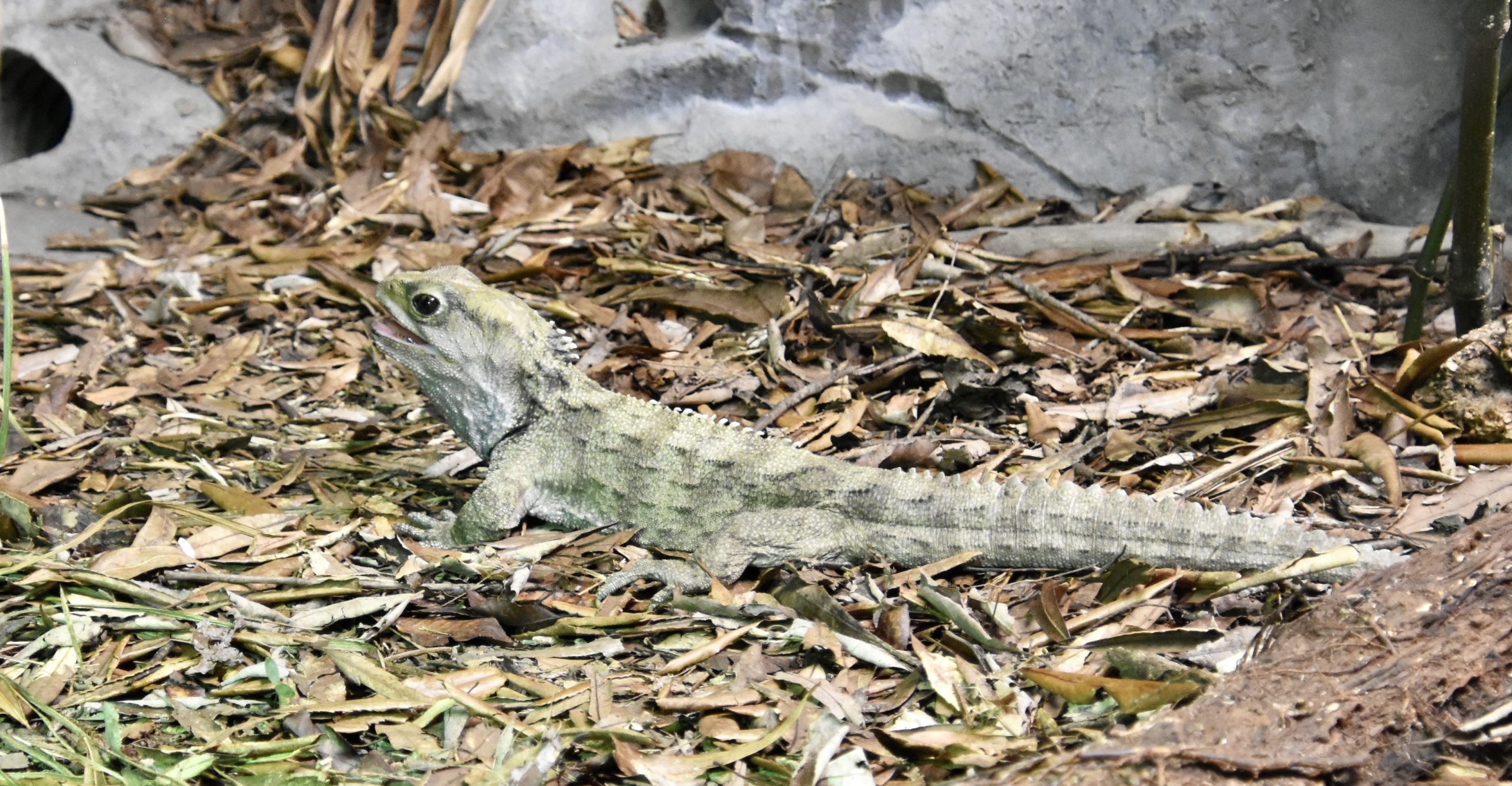
And the third reason to visit is to get a decent look at a kiwi bird. We did get a bare glimpse of one at Te Puia in Rotorua, but here, under infrared light you can watch them going about their business. They’re not easy to photograph under these conditions so you’ll have to take my word that if you want to see a kiwi, this is the place to do it.
There is a lot more to Napier than just the Art Deco District and the Marine Parade. The Ahuriri area features a large marina, many seaside restaurants, lots of seafront green space and more Art Deco buildings including this one which was my favourite of them all.
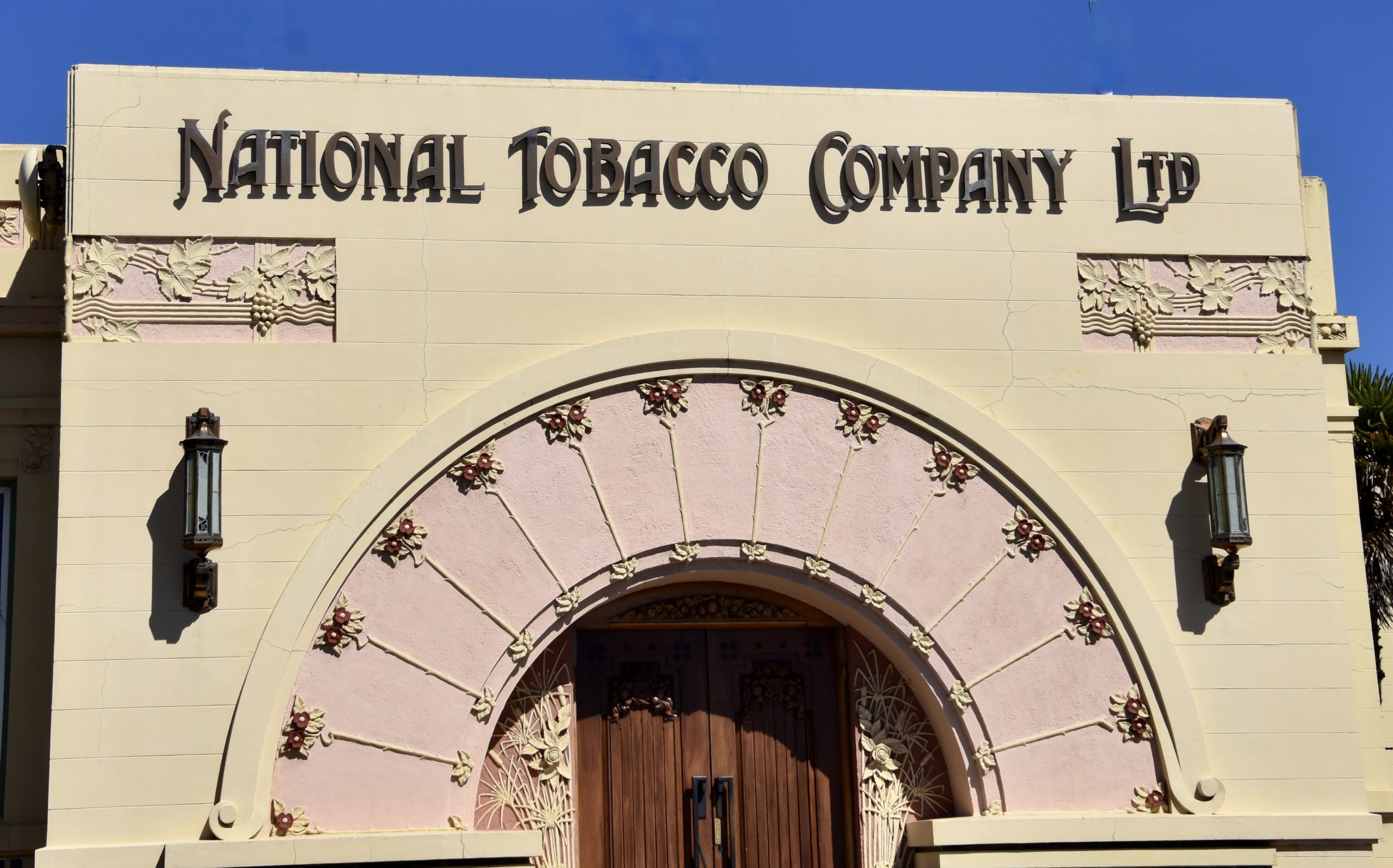
One of the things you absolutely must do while in Napier is to take a tour of some of the 70 wineries in the Hawke’s Bay area, spread over seven distinct terroirs. There are lots of companies offering these tours and we chose Winery Tours Hawkes Bay for our tour of four wineries in the region. It was an excellent choice. This is our driver and guide Lorna who let us indulge in the tasting of at least twenty different wines while she had to abstain. I couldn’t have done it.
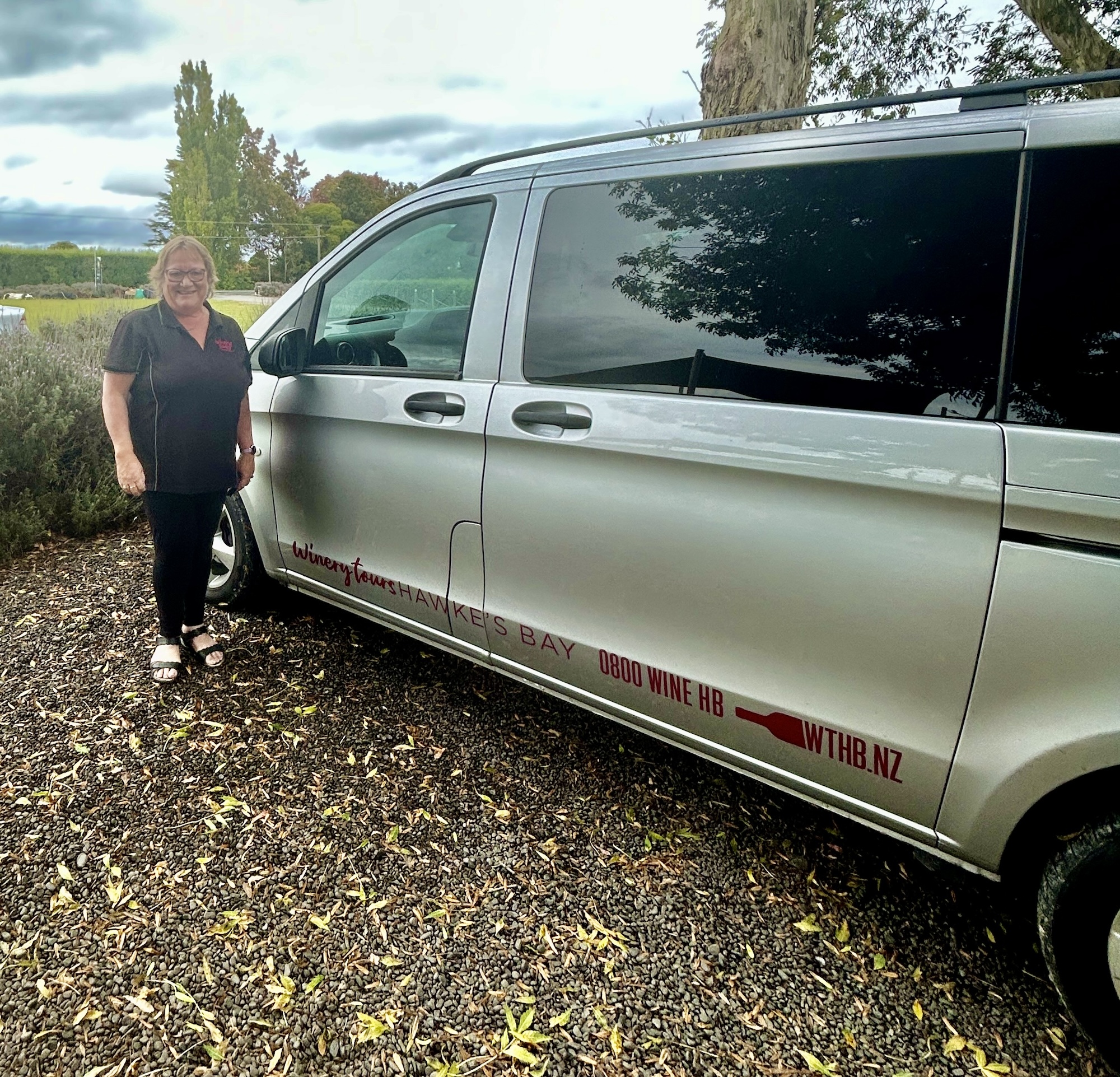
The bottom line was that we came away with enough wine from Pask and Trinity Hill in the Gimblett Gravels region to last the rest of the trip. The pinot gris, chardonnay and pinot noirs these wineries are producing are simply out of this world. I would go back to New Zealand just for these, as you can’t get them in Canada.
Napier Restaurants
If I haven’t convinced you by now that Napier is a must visit in New Zealand, let me throw one more enticement at you – the food is f***ing unbelievable. Over the course of our stay we did not have any meal that wasn’t exceptional. Let’s start with breakfast at the Ajuna Eatery.
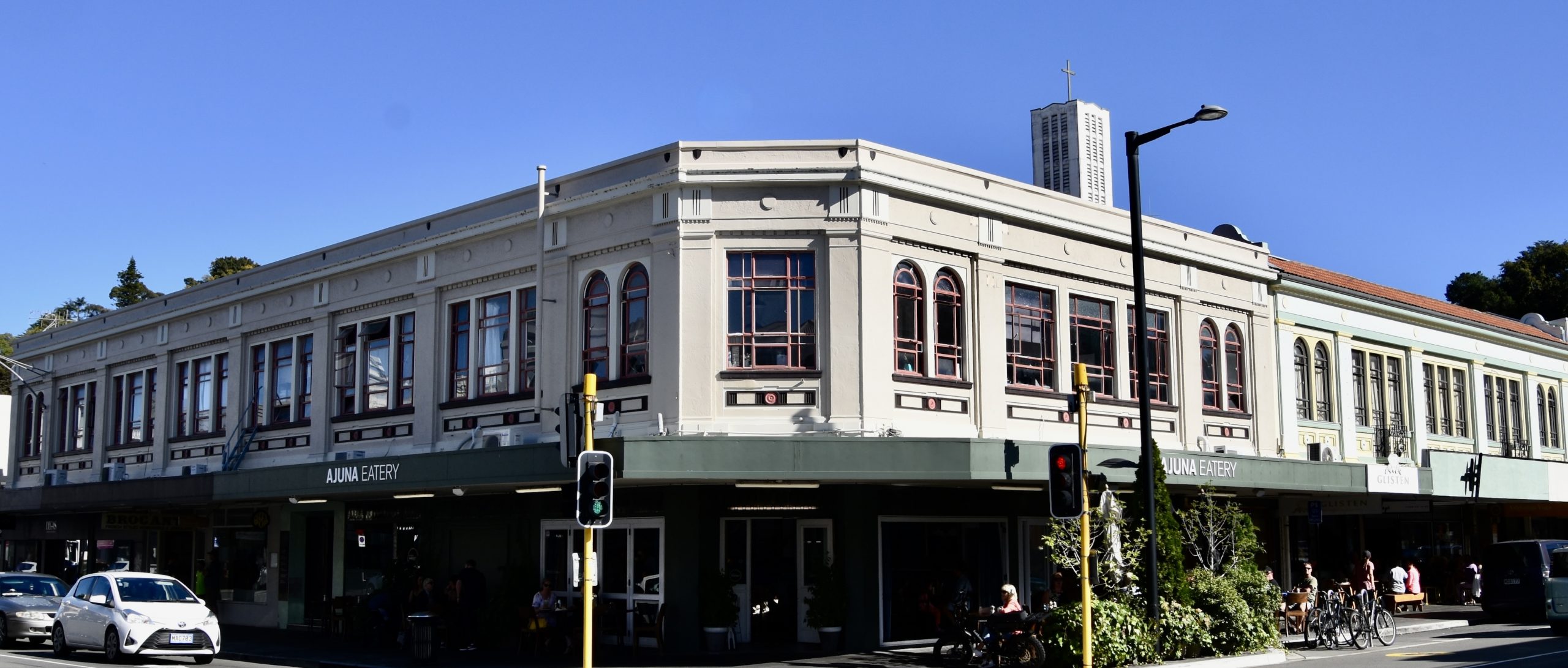
This is their version of avocado toast which is Alison’s go to breakfast choice.
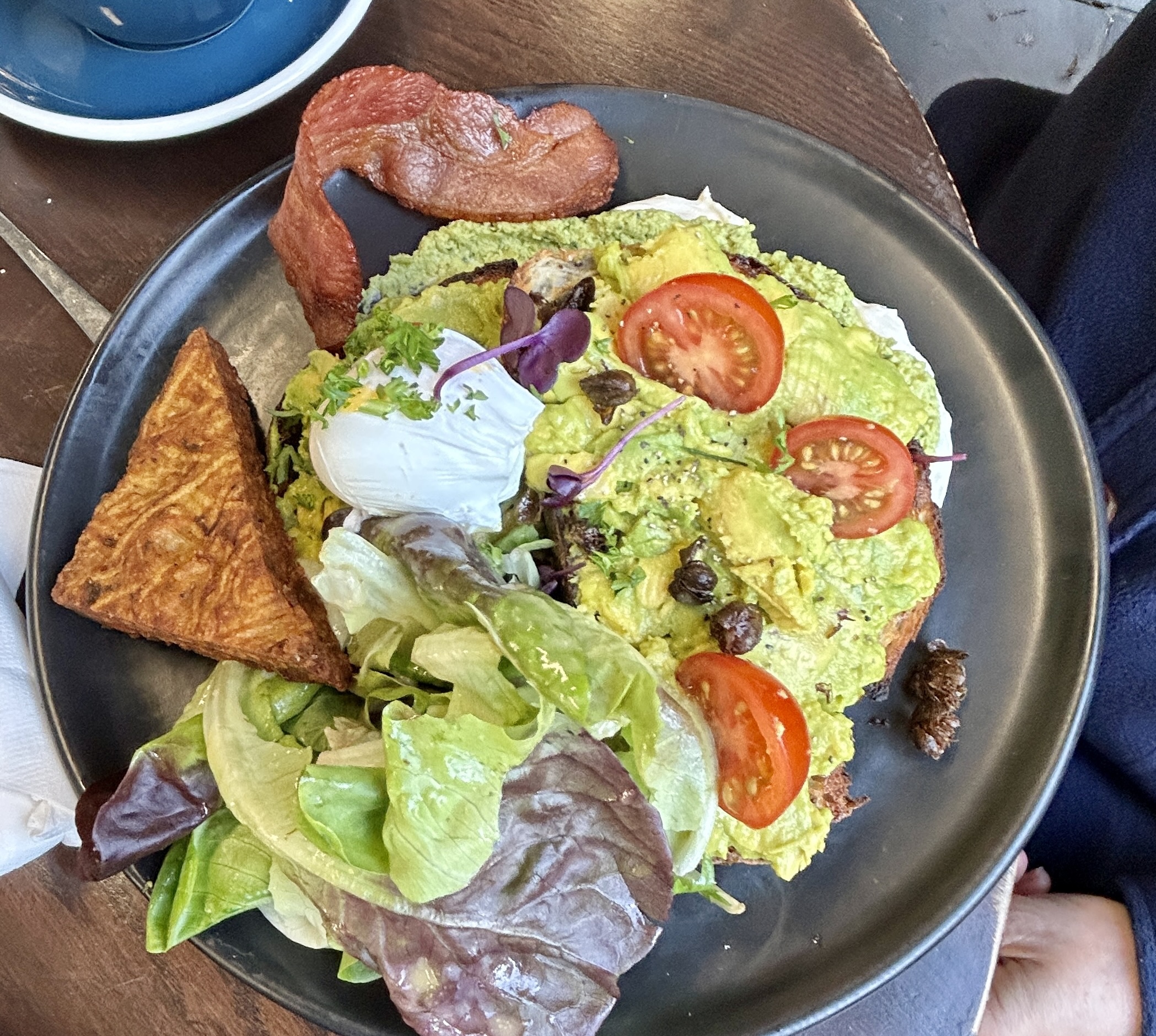
My choice was poached eggs and bacon. The eggs were perfect and the bacon crisp.
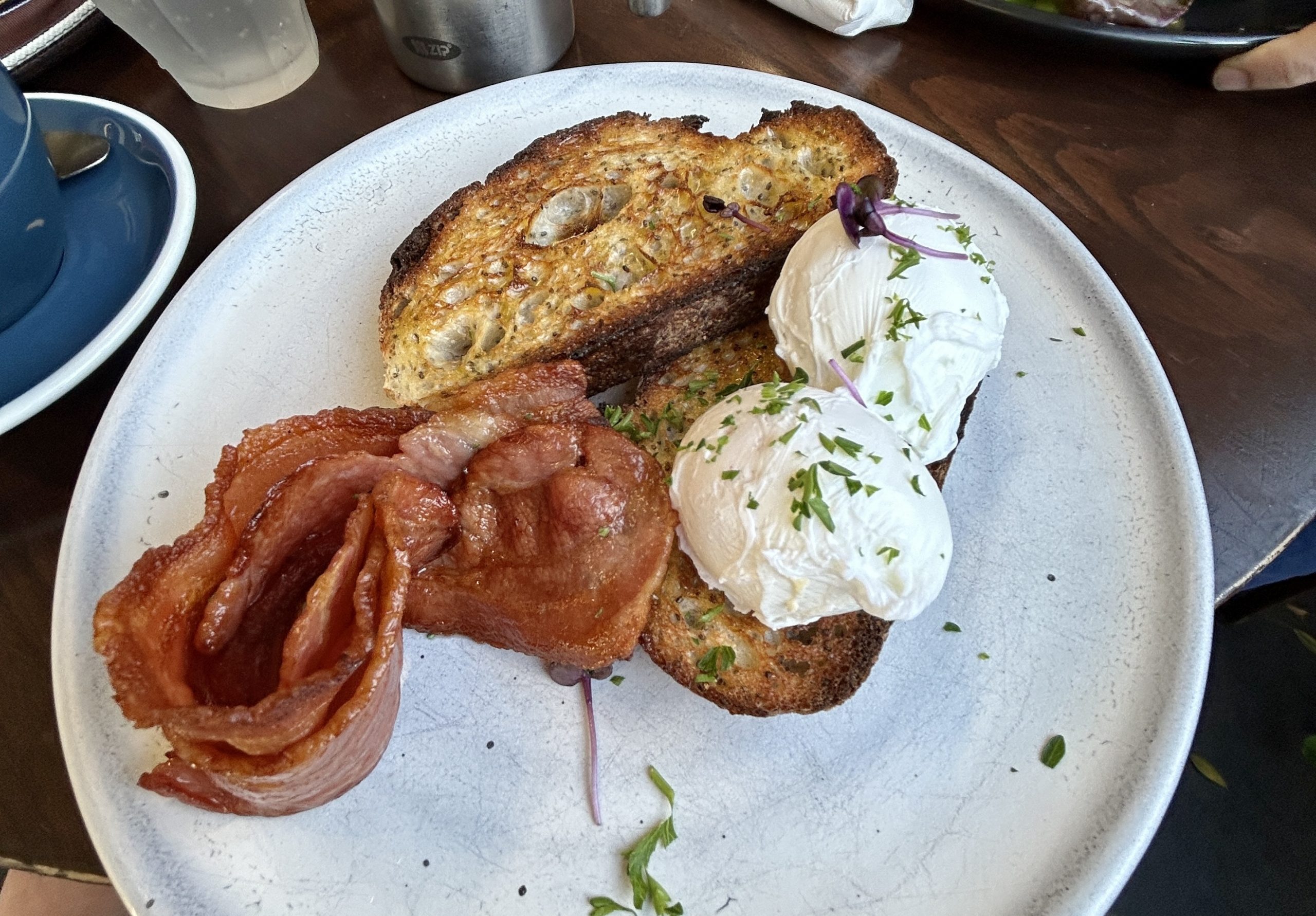
When you find a place this good for breakfast you don’t need to look anywhere else, and we didn’t.
Right next door is Vinci’s Pizza which is serving up what has to be some of the best pizza in the country.
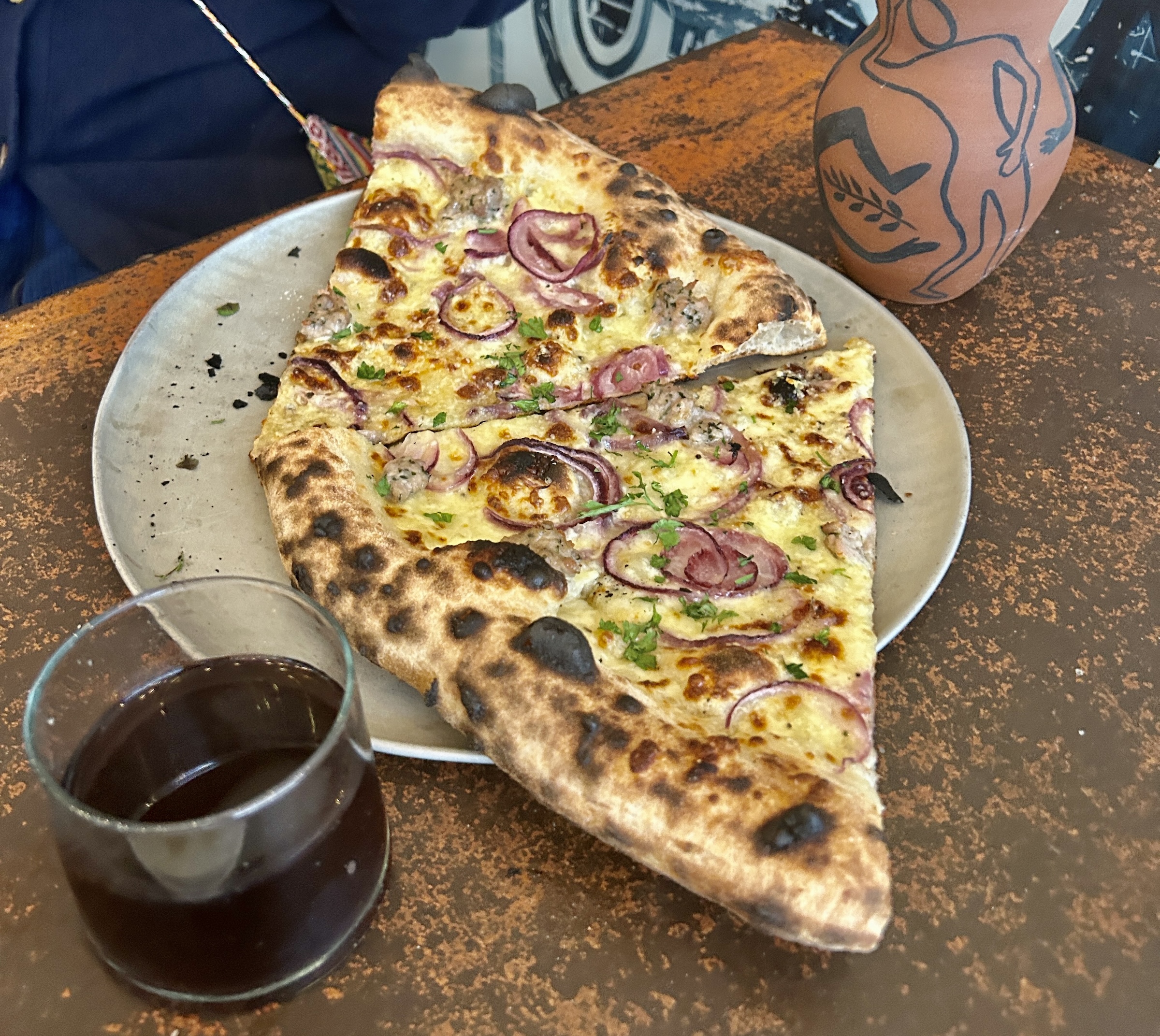
How about some of that famous New Zealand seafood? Look no further than the rather off putting named Hunger Monger which we also visited more than once during our stay in Napier. Despite the stupid name, it is serving beautiful looking and tasting sashimi.

If you like your fish cooked, as does Alison, the John Dory is a hard to find delicacy. With a side order of Brussels sprouts and grapes it makes for a great meal.
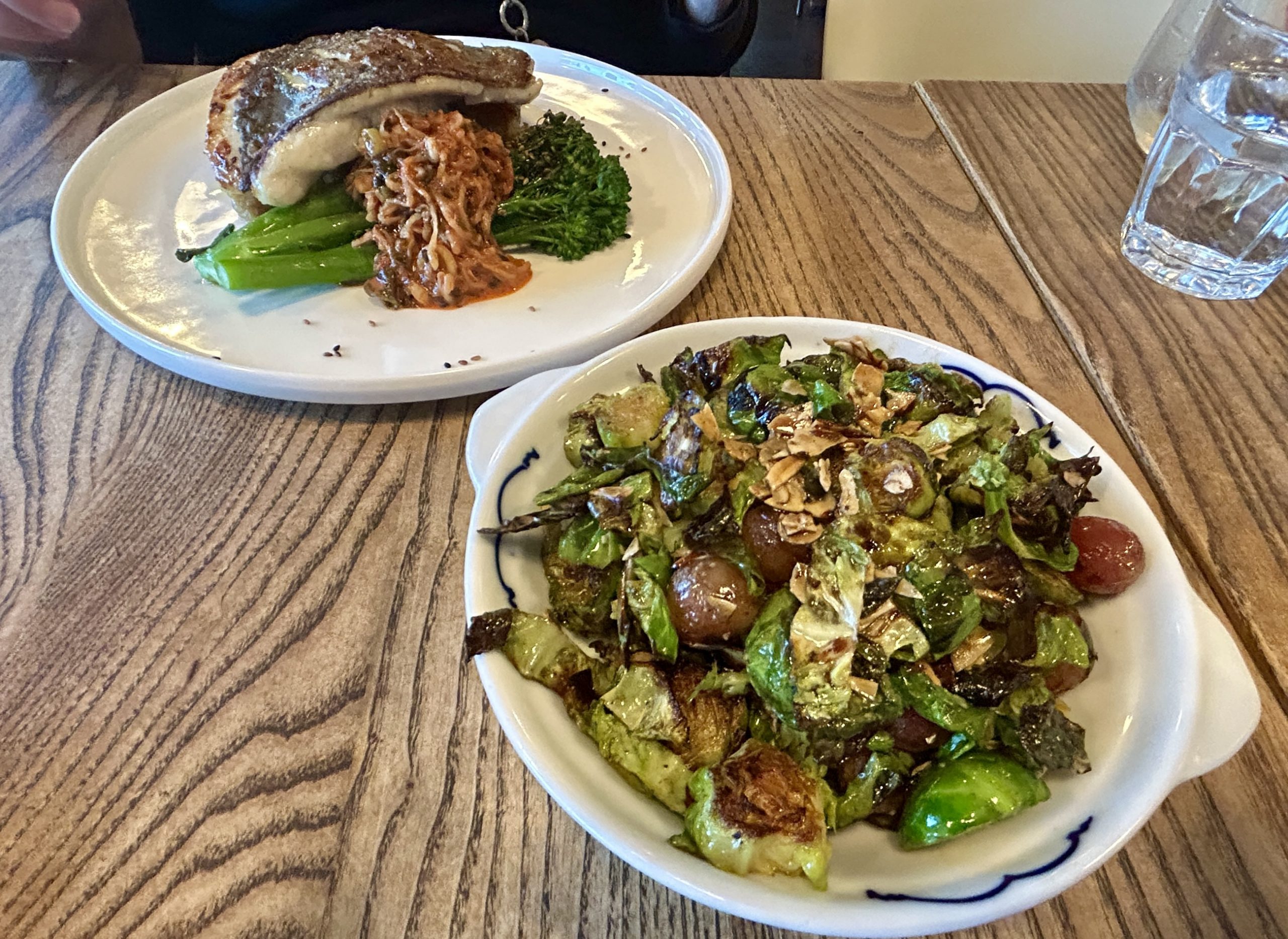
Nearing the end of our trip, we decided to splurge and there is no better place in Napier than the Central Fire Station which is located in the former Central Fire Station.
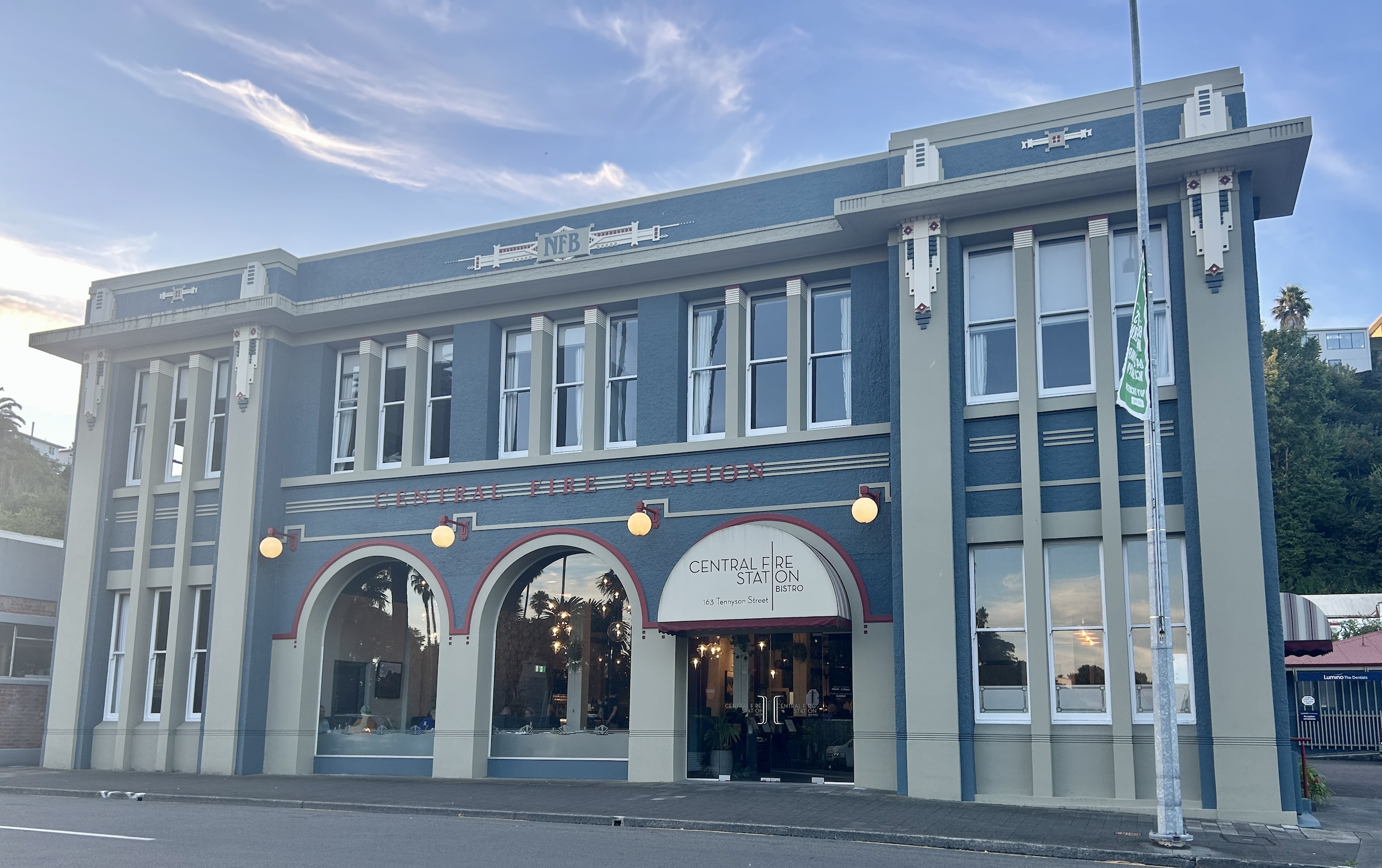
It has an open kitchen and some really nice banquettes, two things that I think make for great ambience.
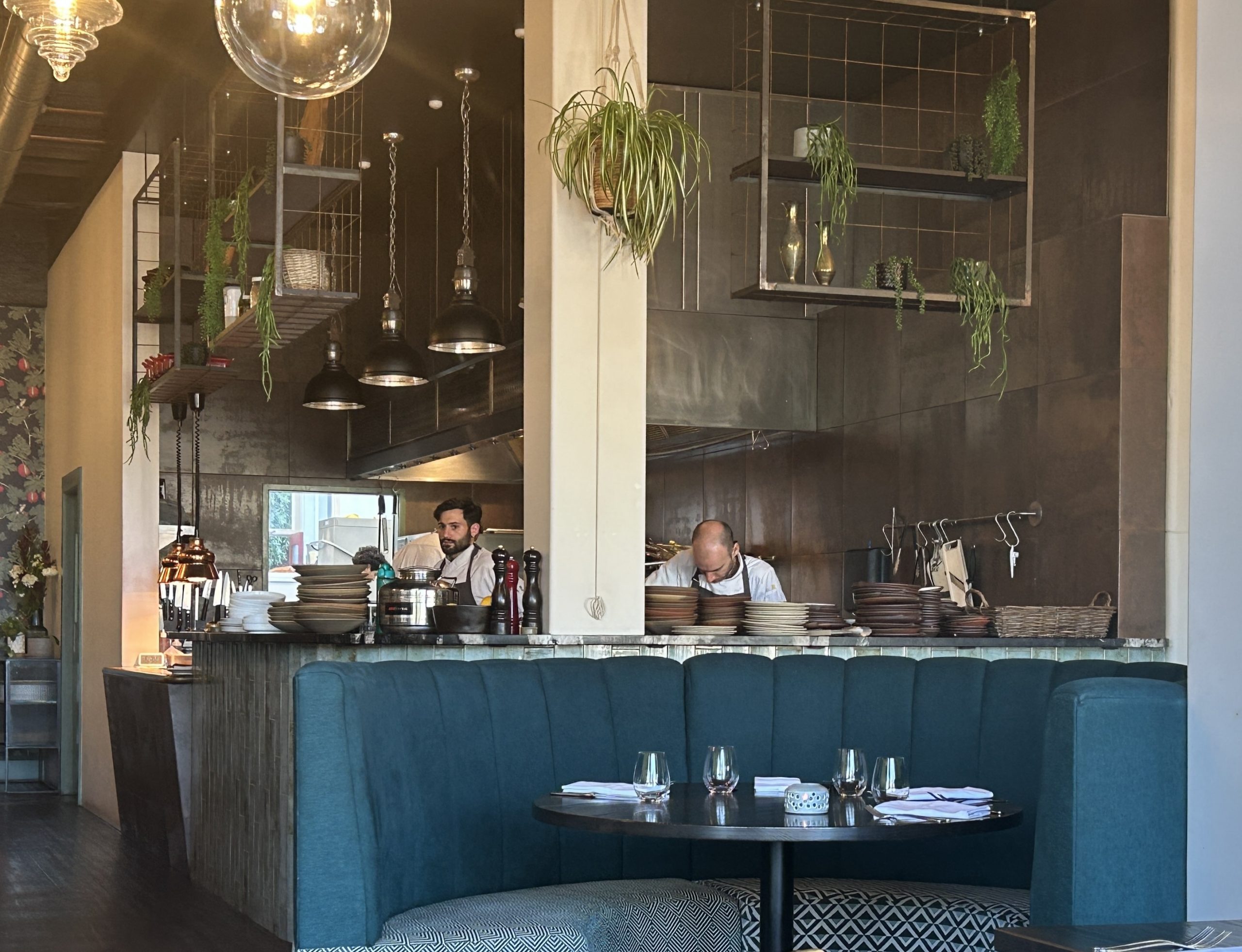
I’ll start with half a dozen oysters with a chardonnay mignolette.
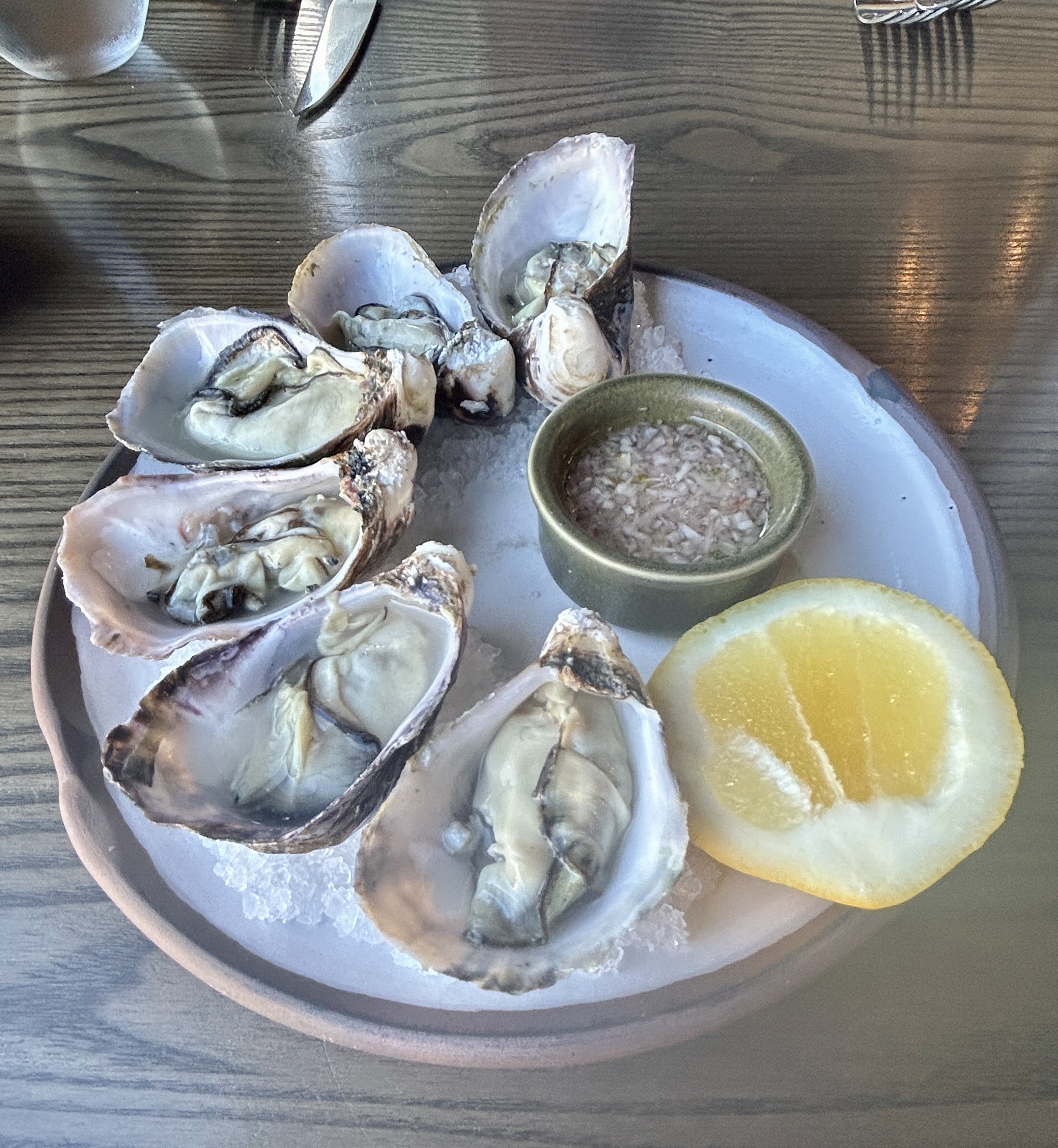
While Alison has a simple green salad.
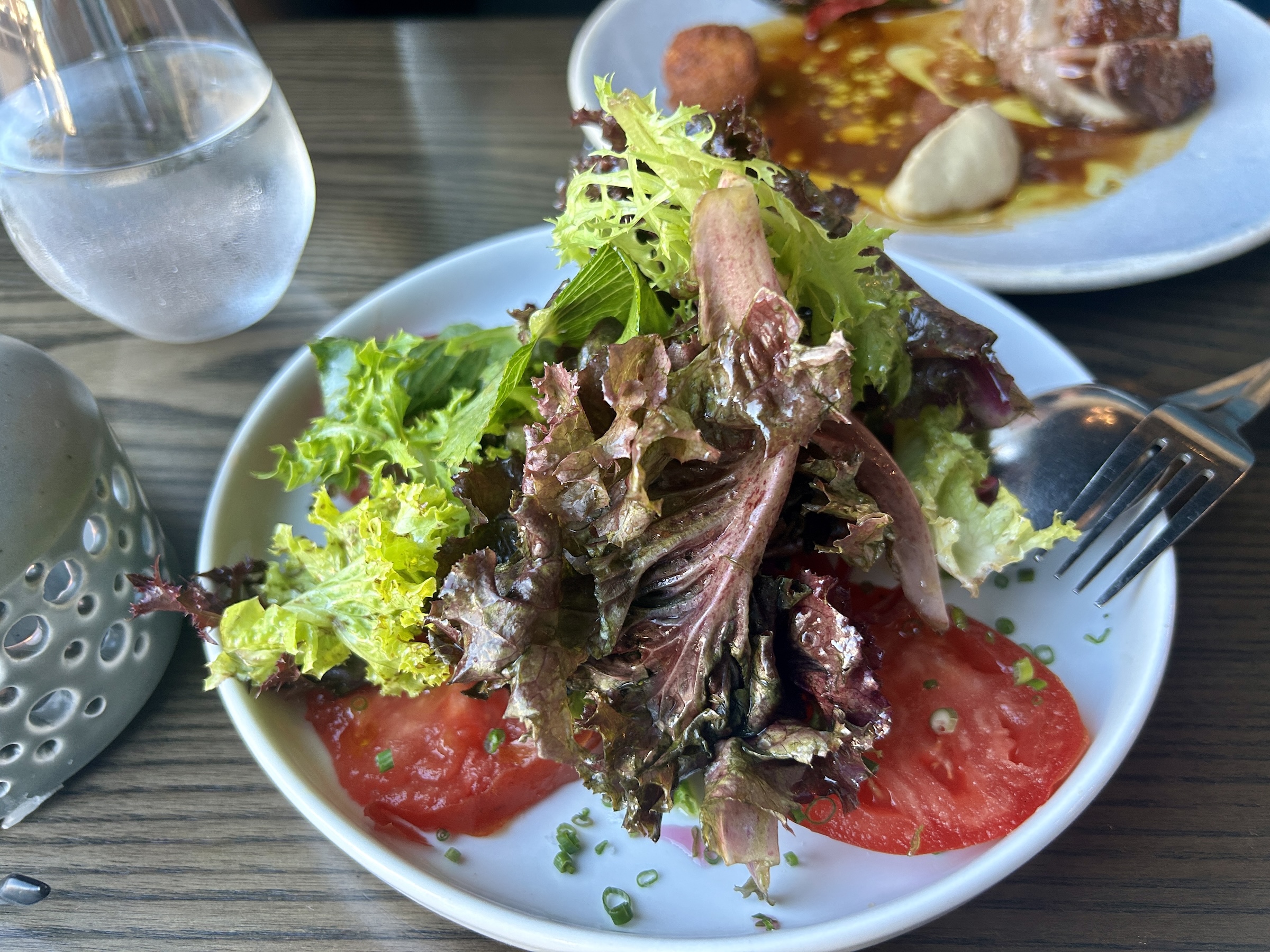
I’m running out of places to have New Zealand lamb so I could not resist the roast lamb with aubergine butter. It tasted as good as it looks.
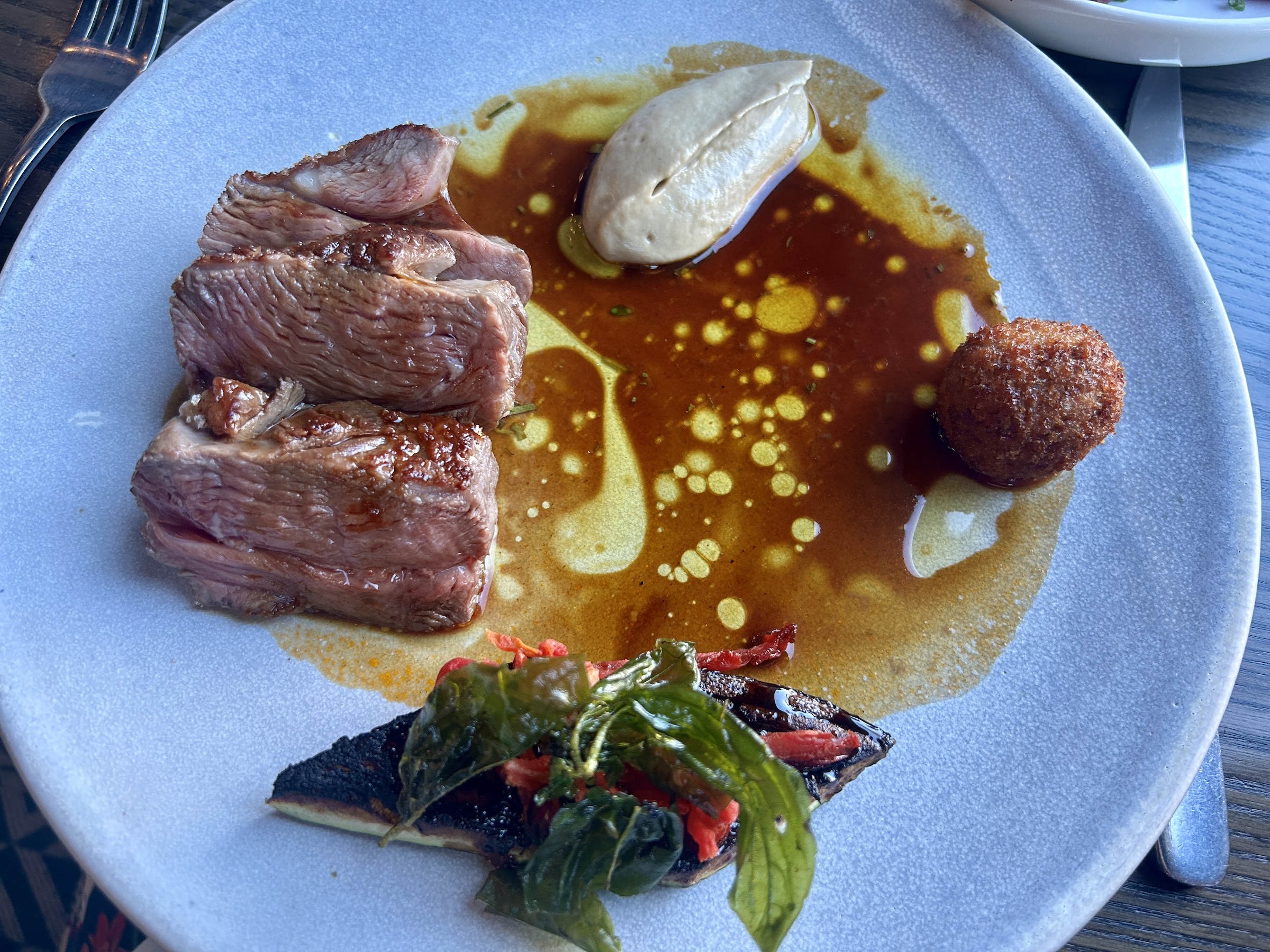
Alison stuck with seafood and once again a fish you don’t often find on menus, flounder in a heavenly leek and fennel beurre blanc.
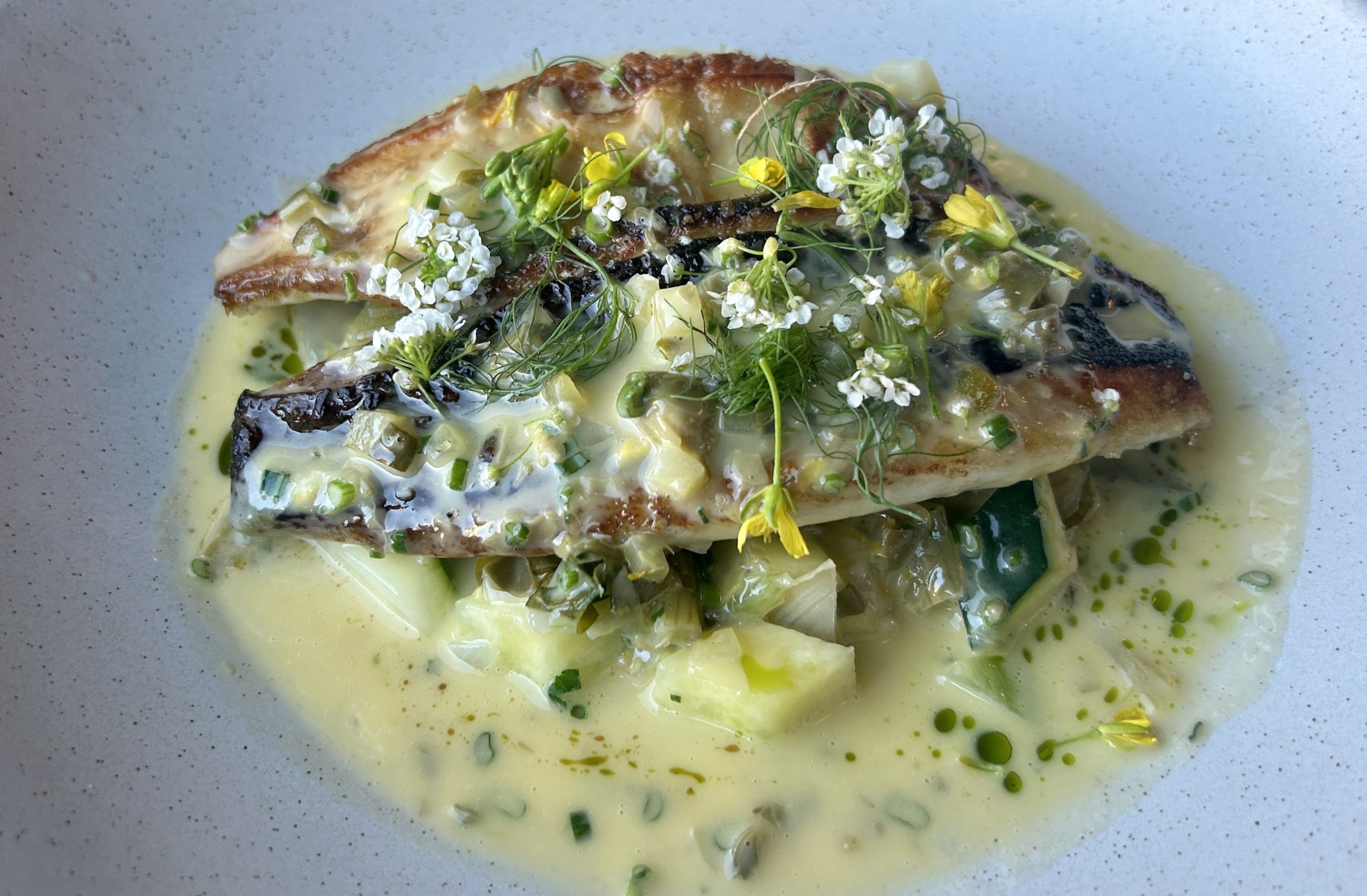
For dessert we shared a strawberry semifreddo.
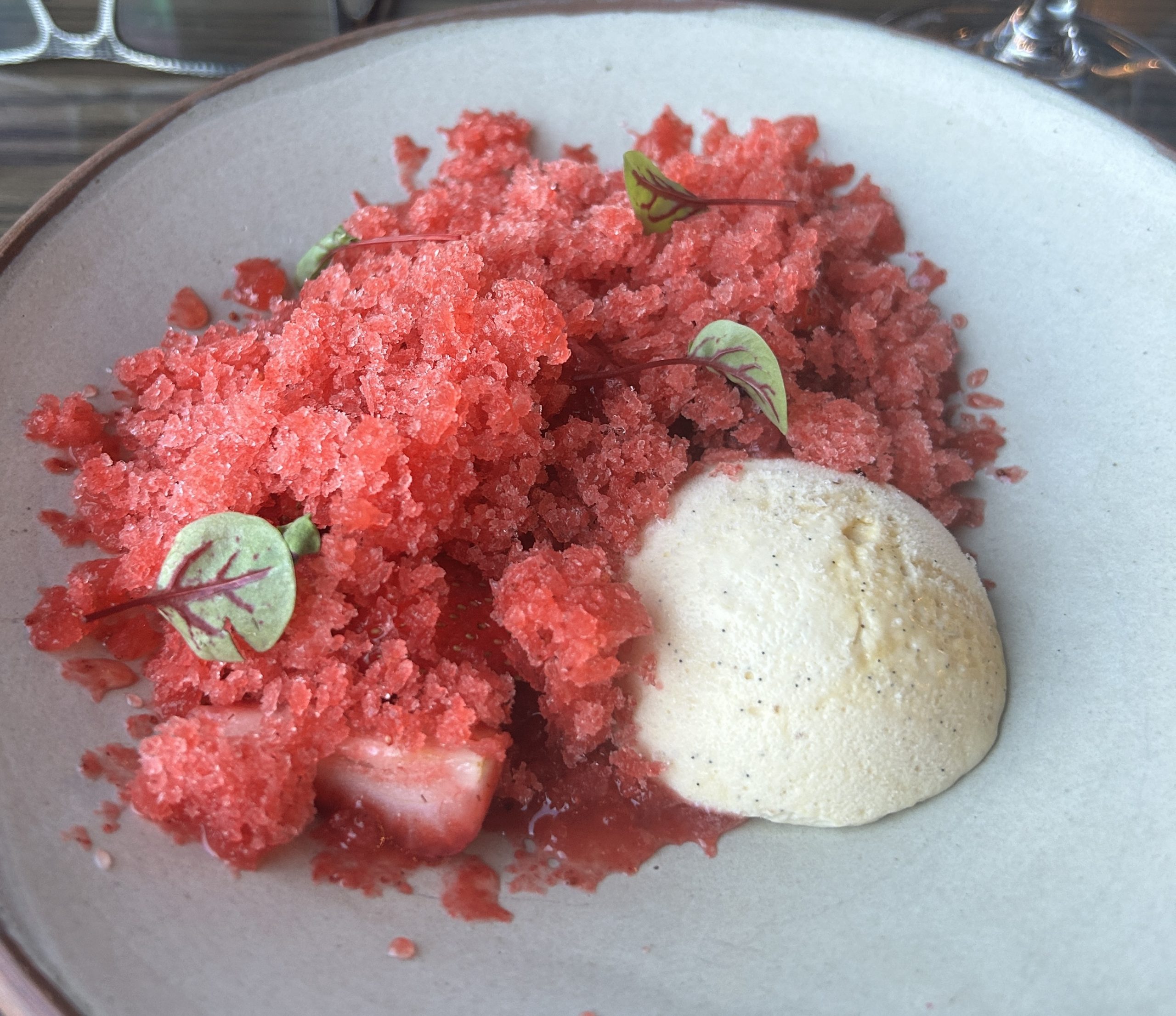
On that note it’s time to head back to our balcony on the Motel de la Mer and toast the sunset with a glass of pinot gris that we bought on our winery tour earlier in the day. Things don’t get much better than they do in Napier, a place almost too good to be true.
In the next post we’ll head to nearby Cape Kidnappers for a round of golf at one of the top golf courses in the world. Hope you’ll play along with us.


